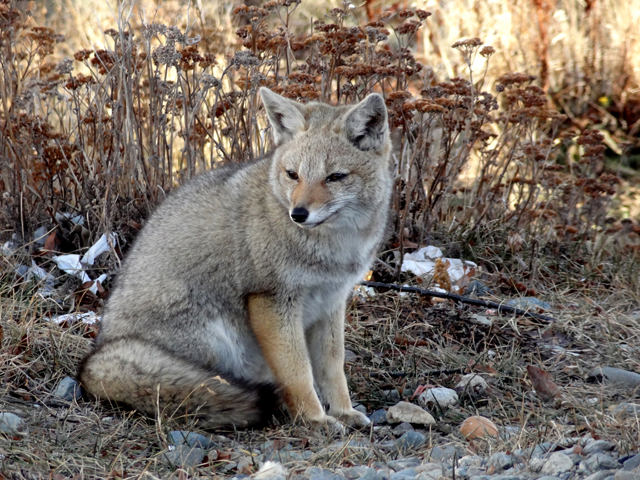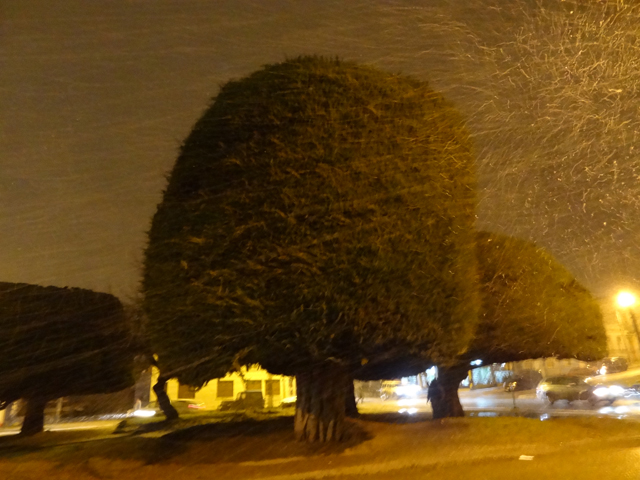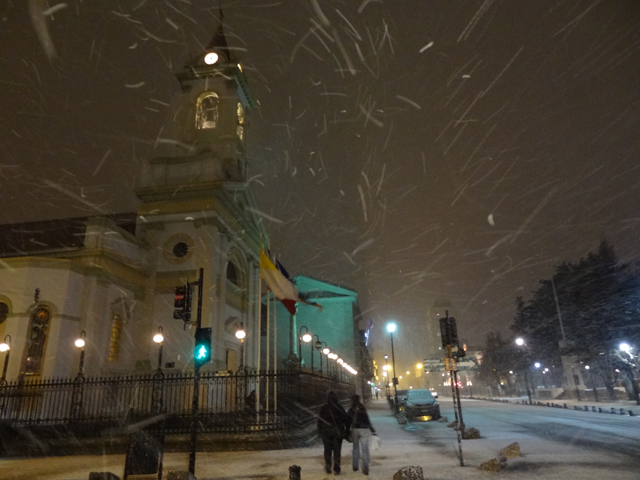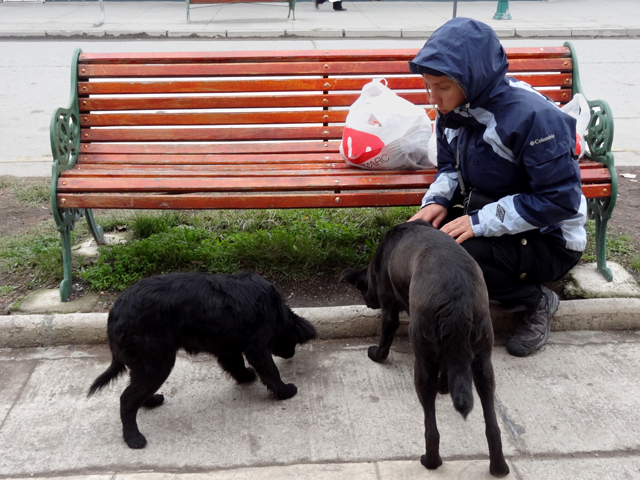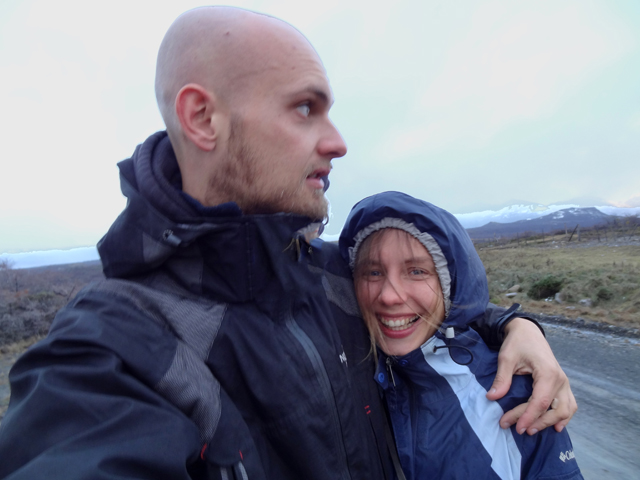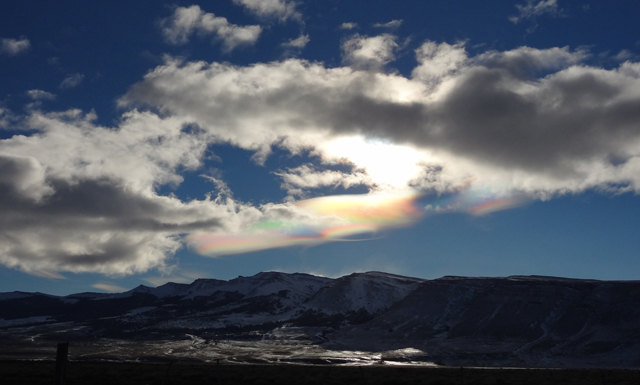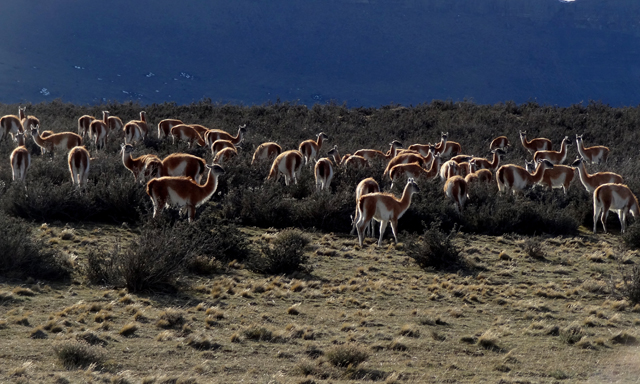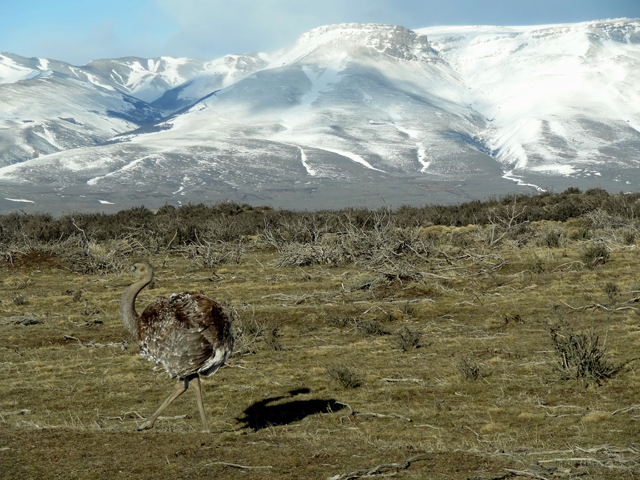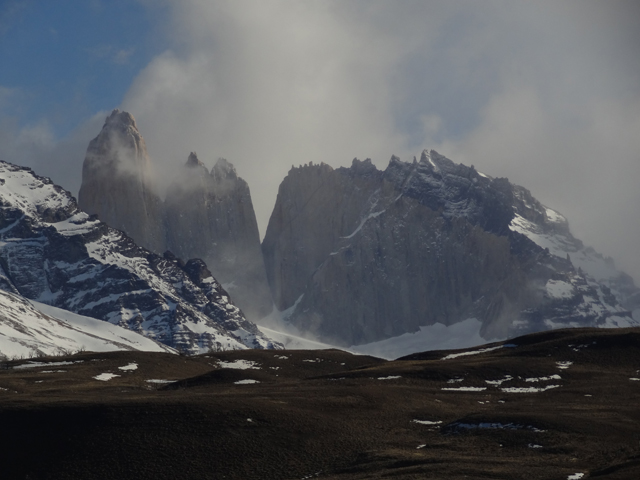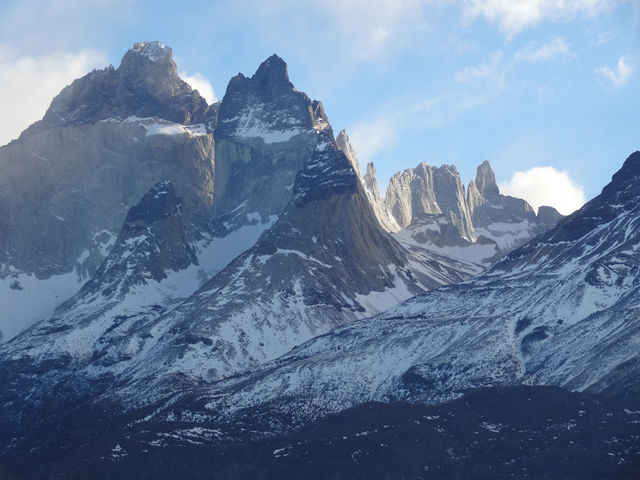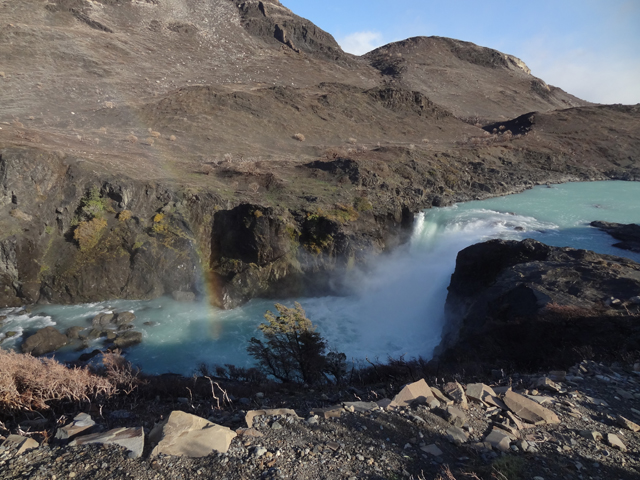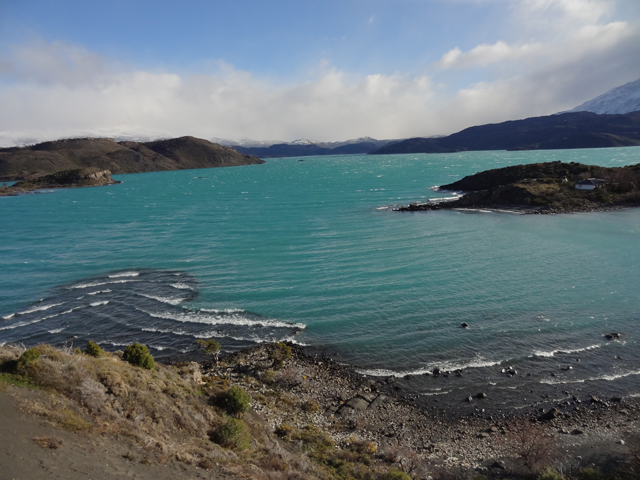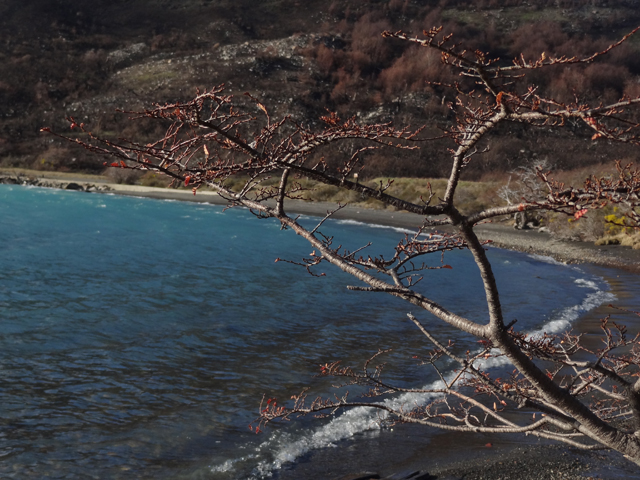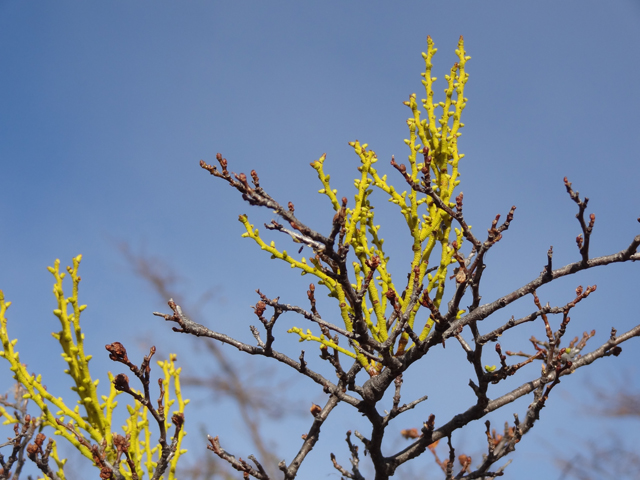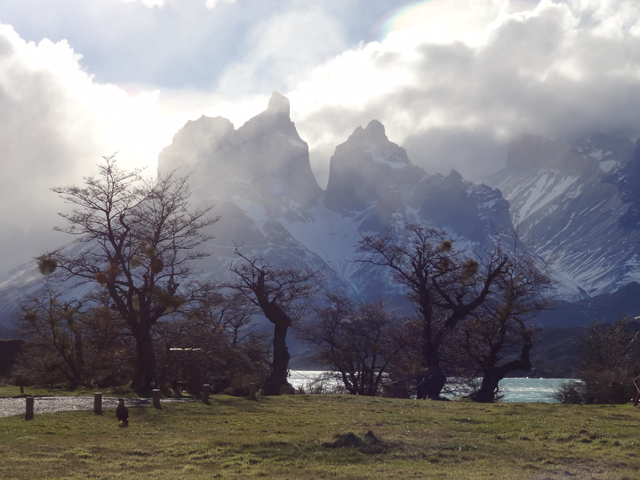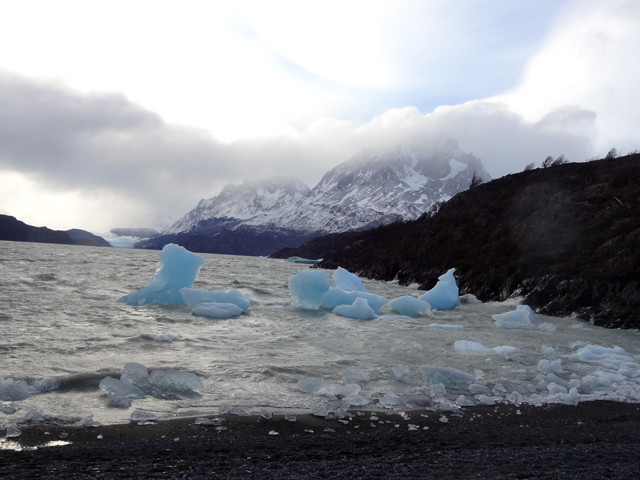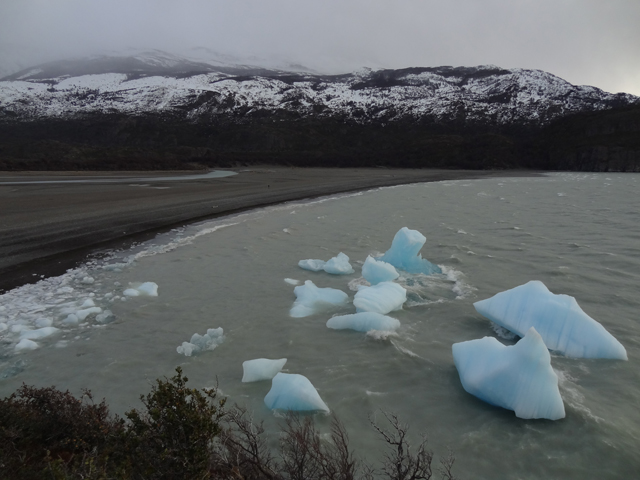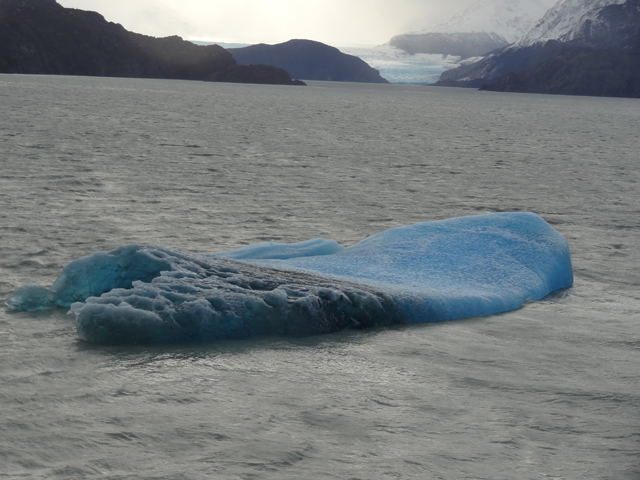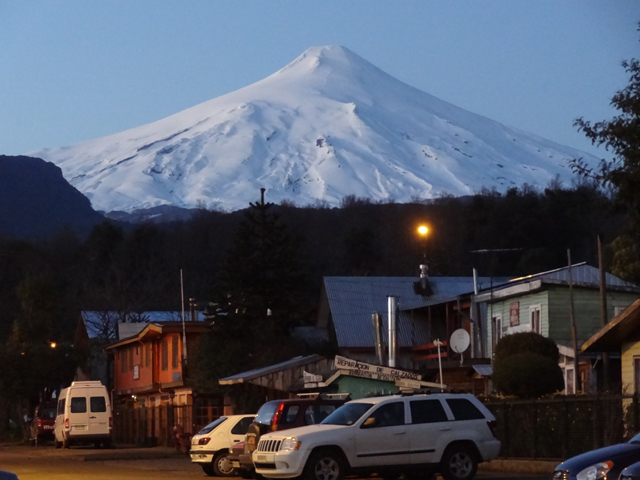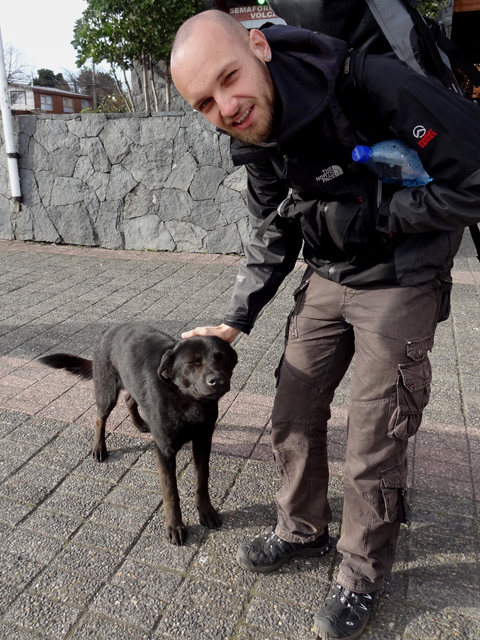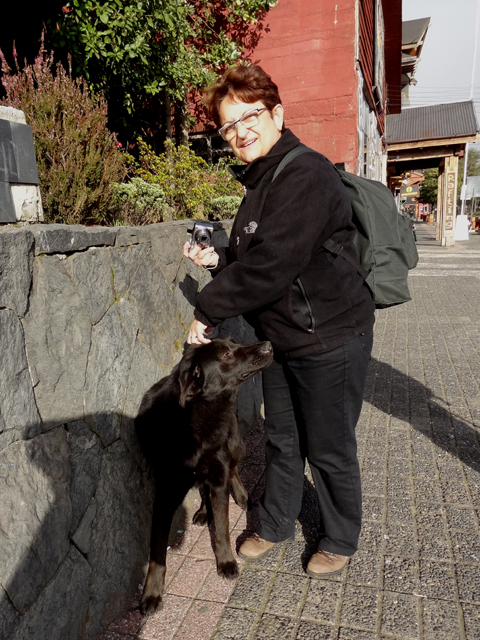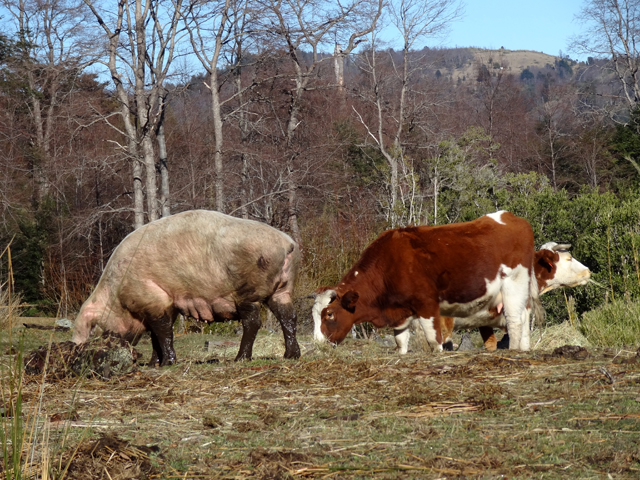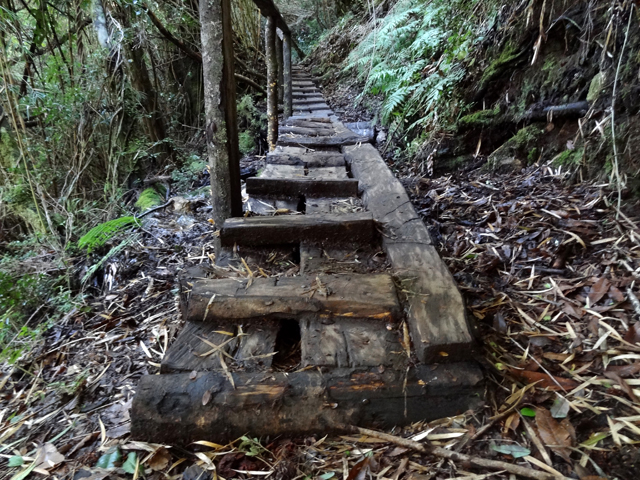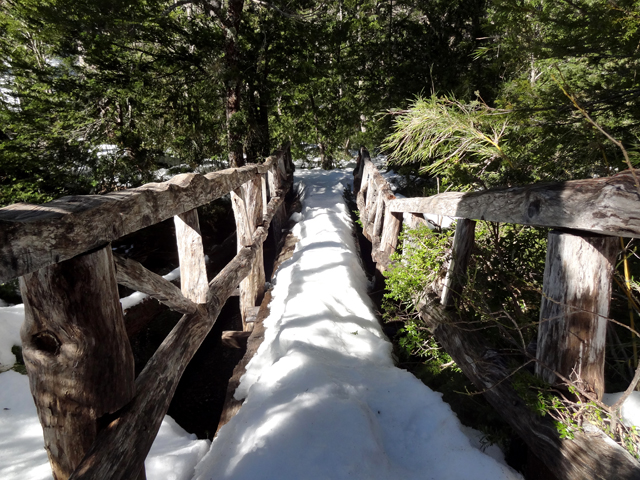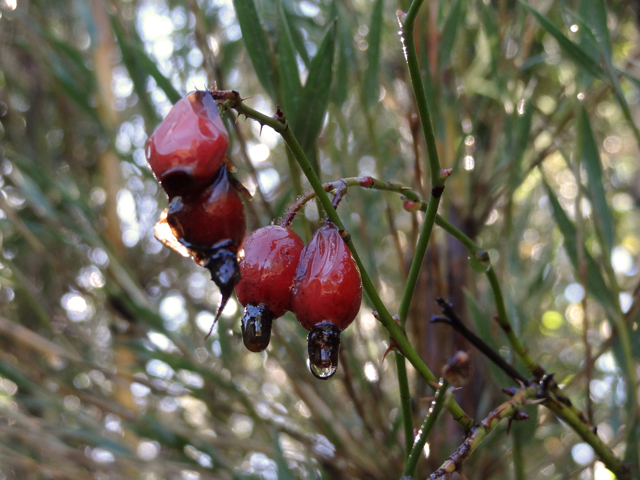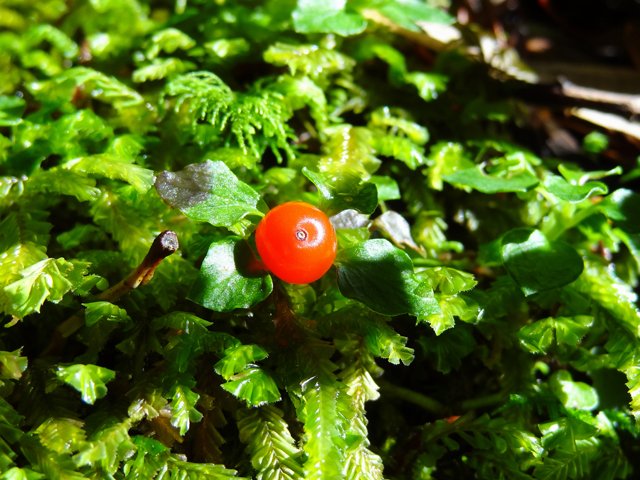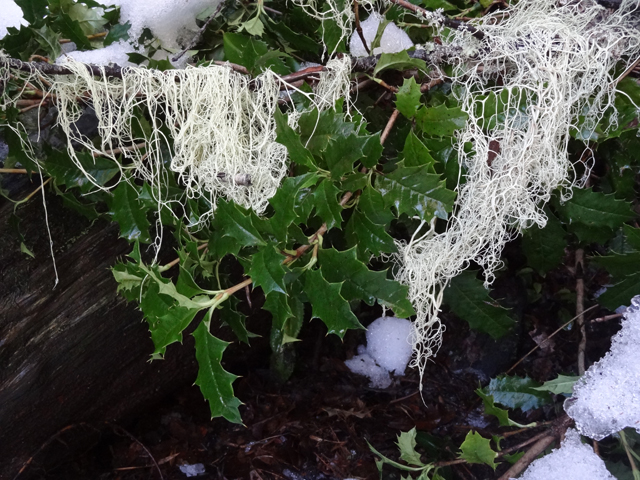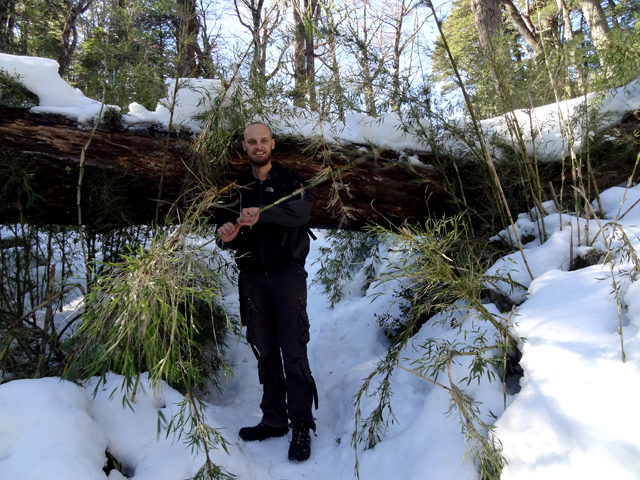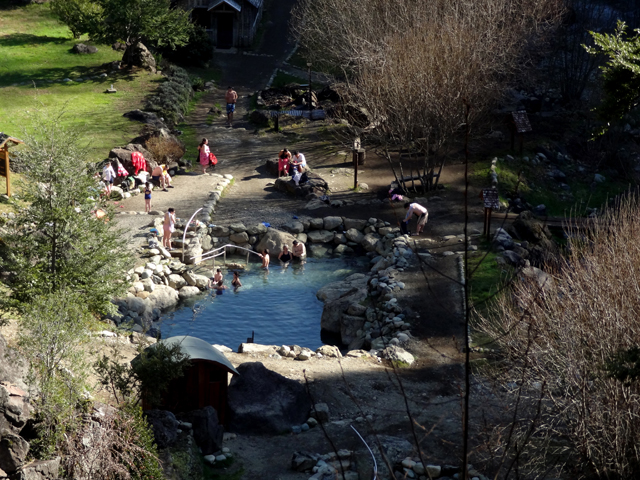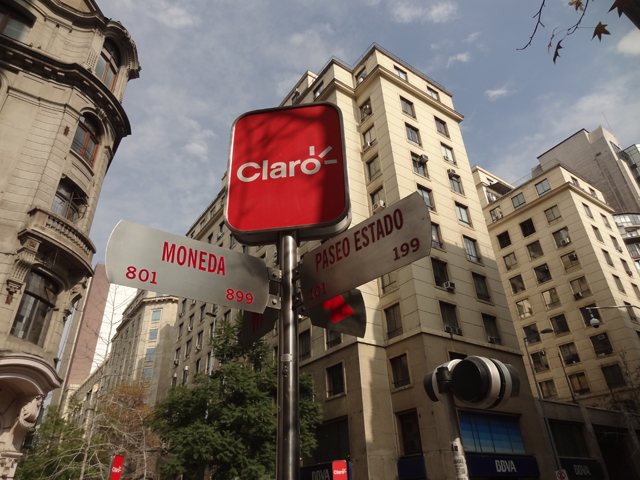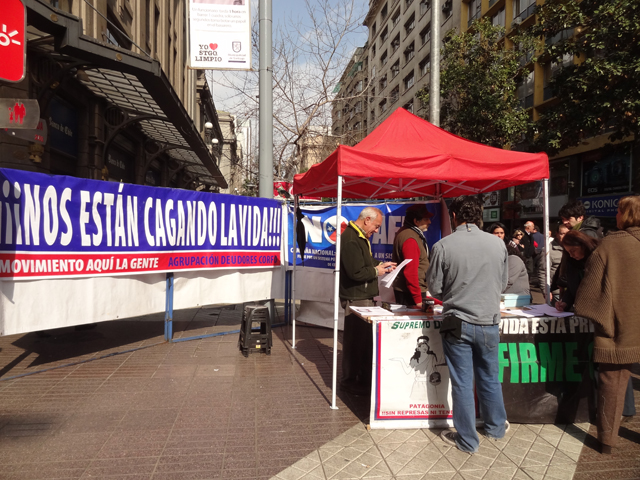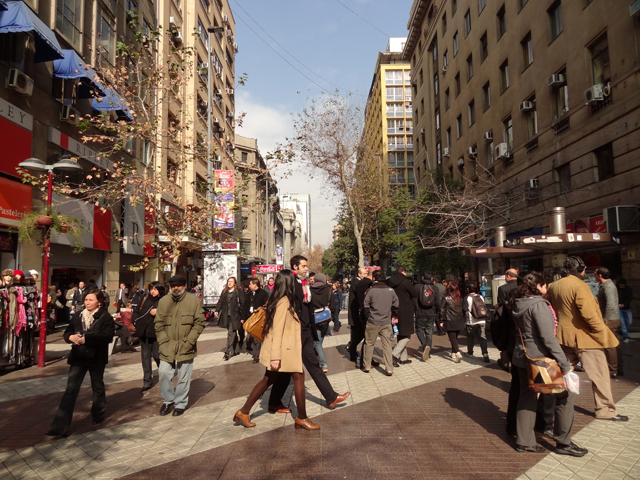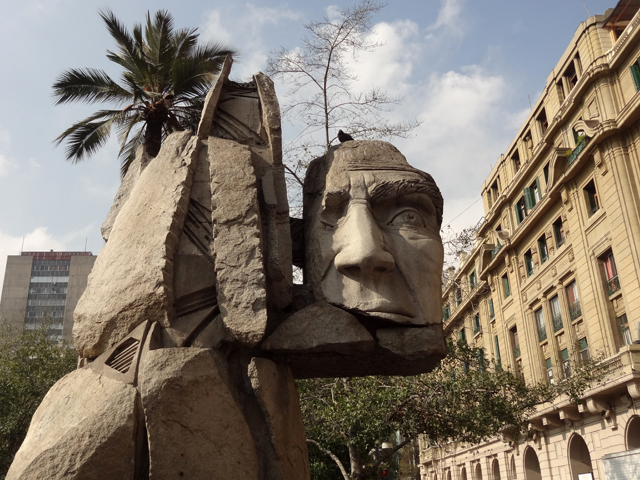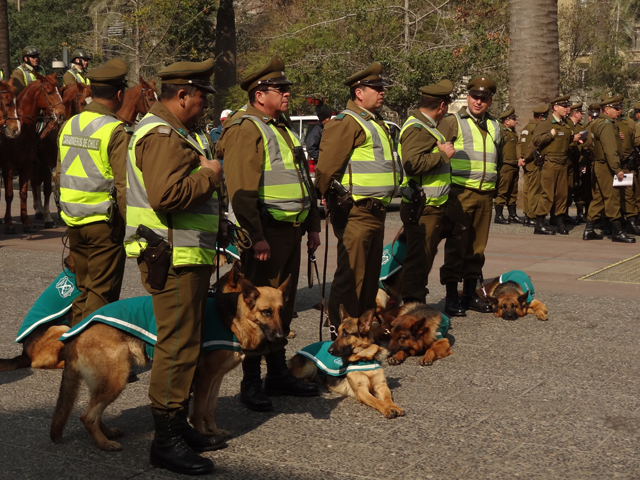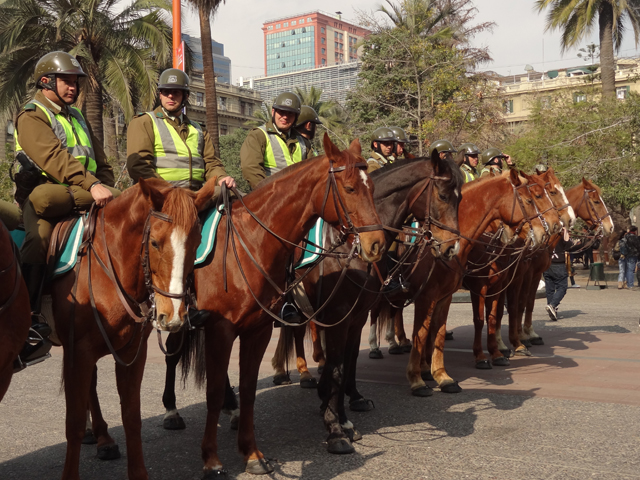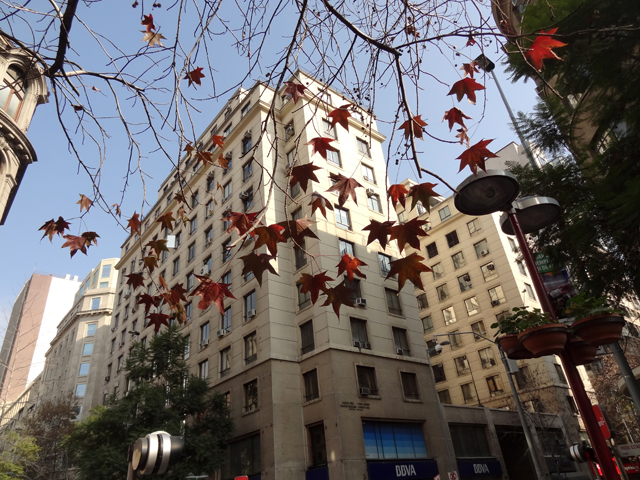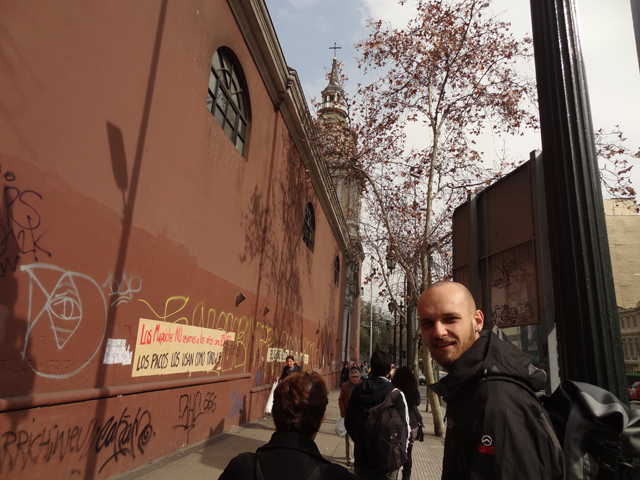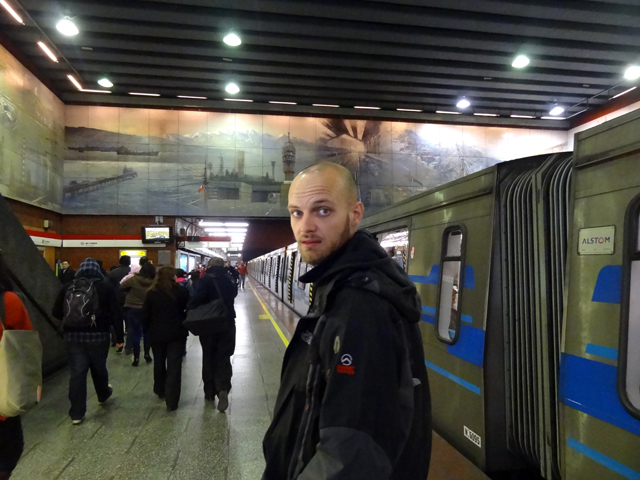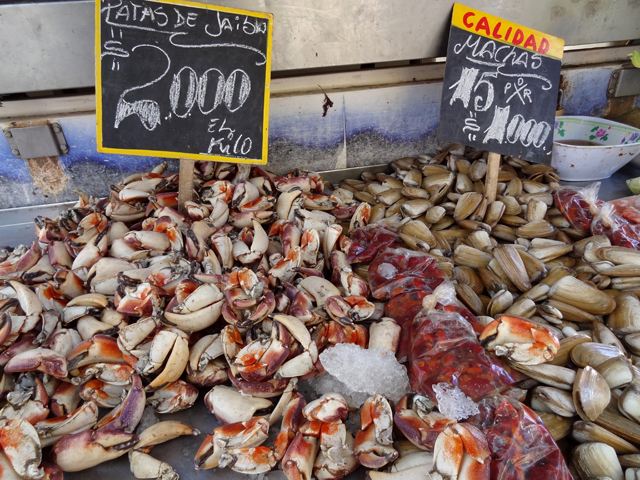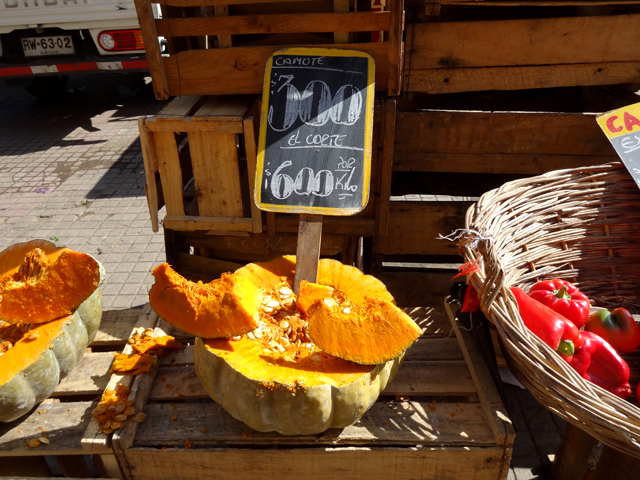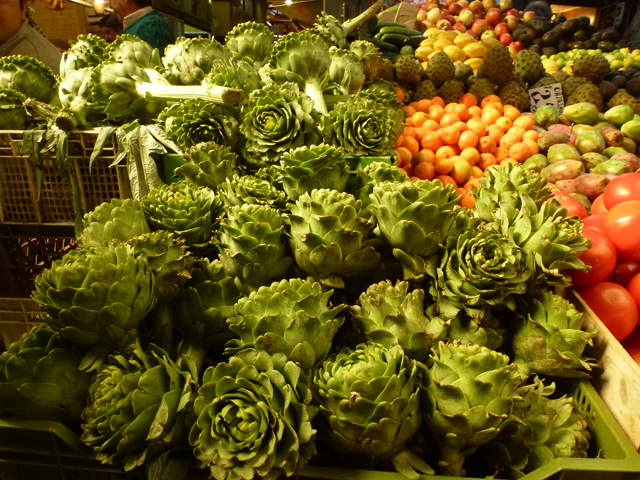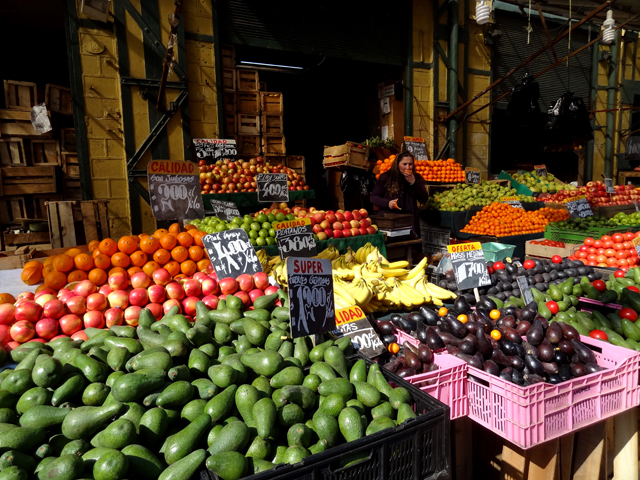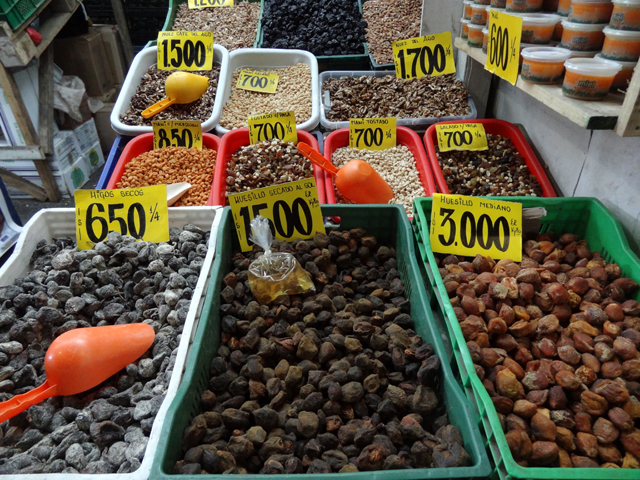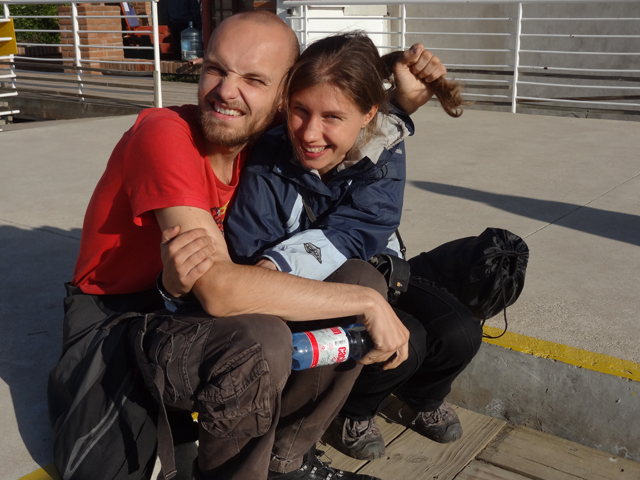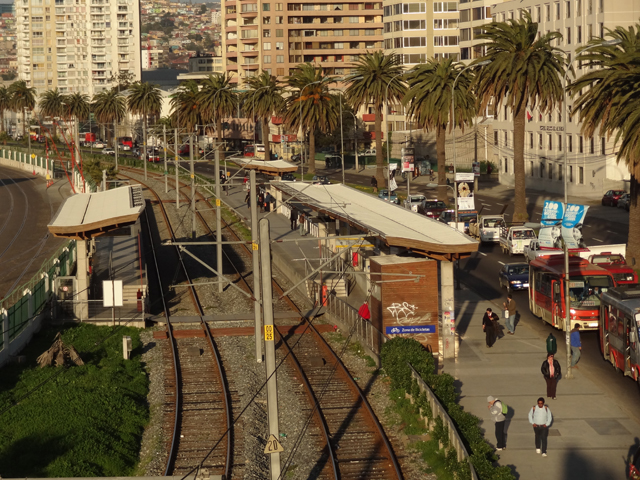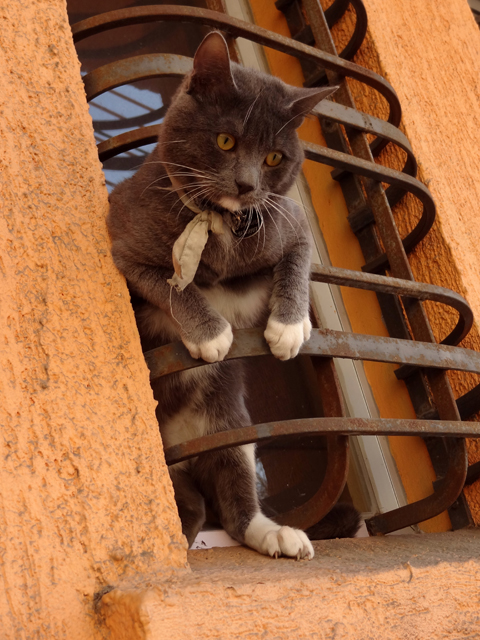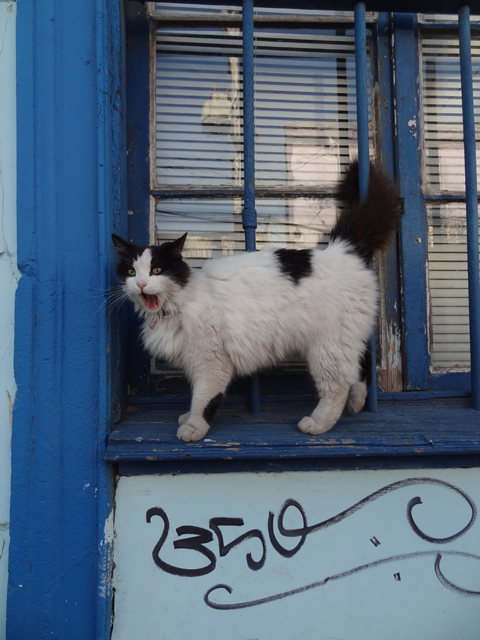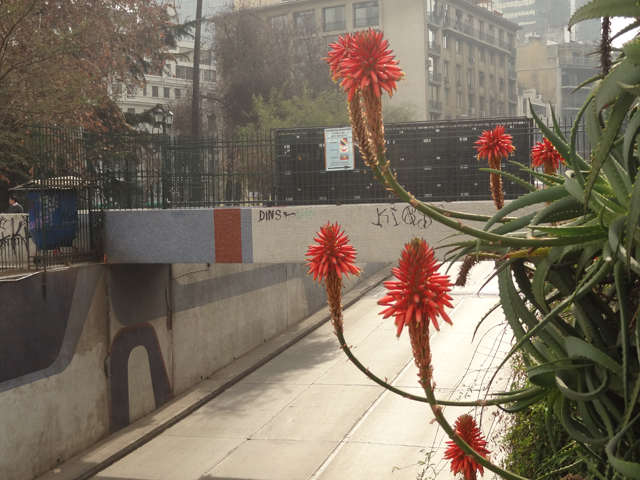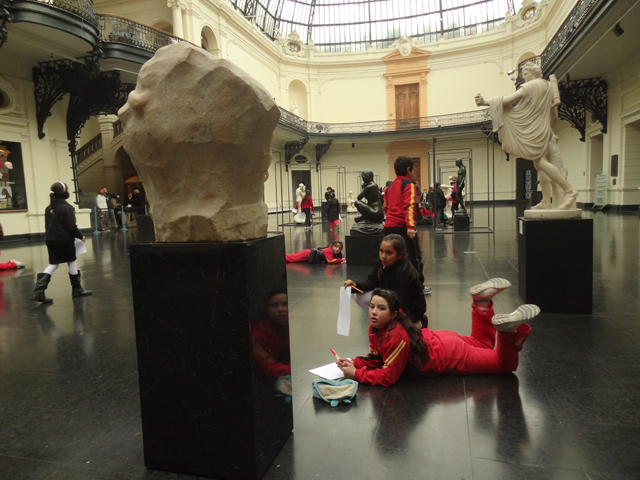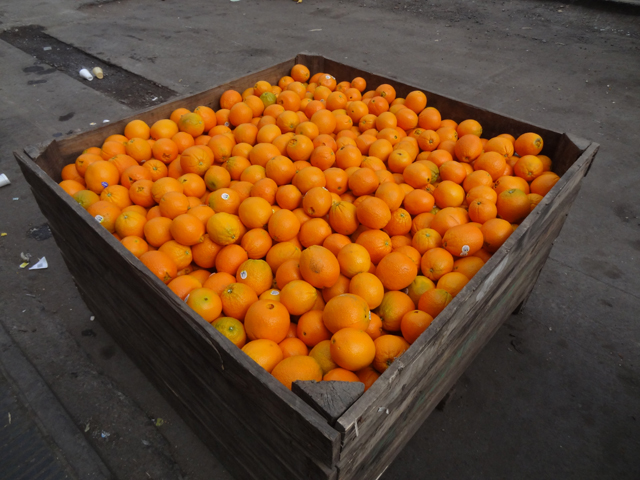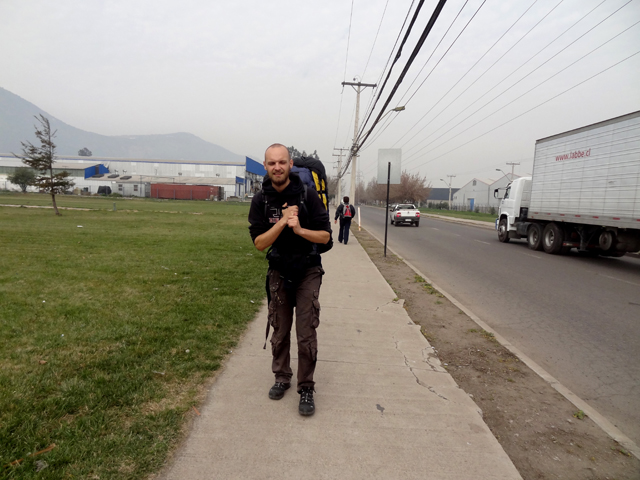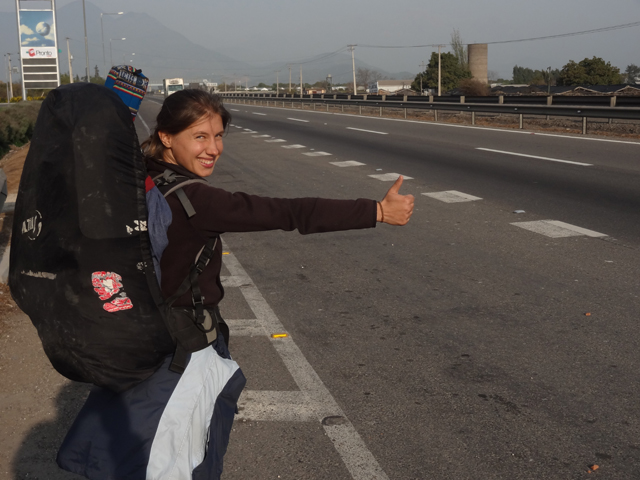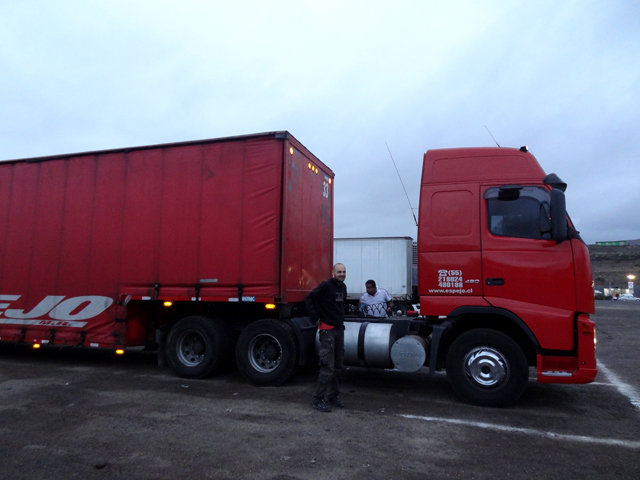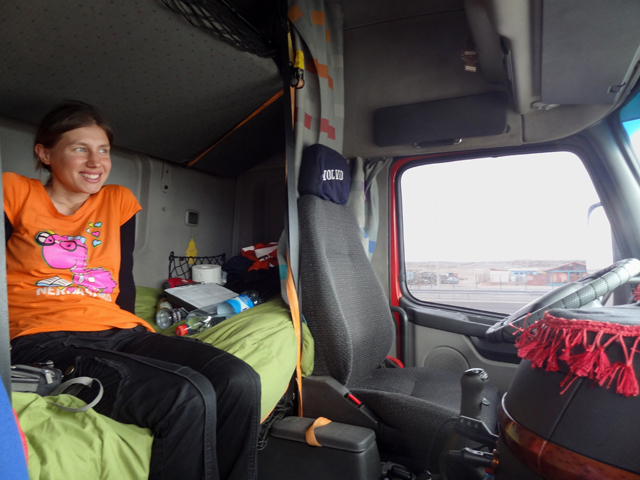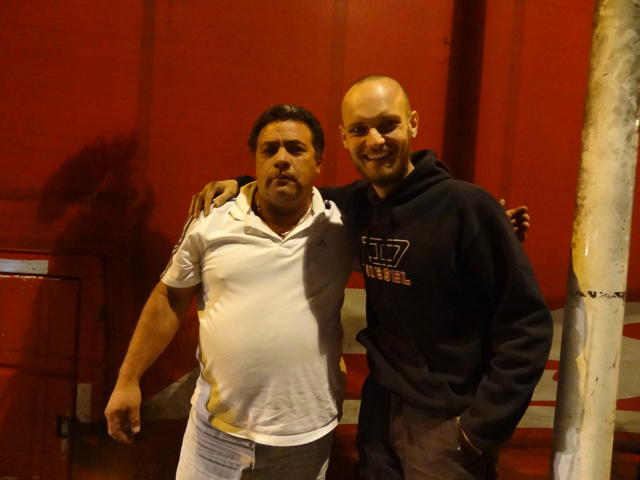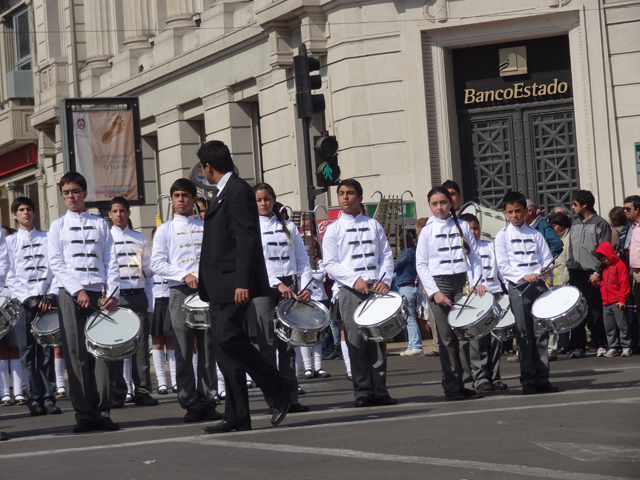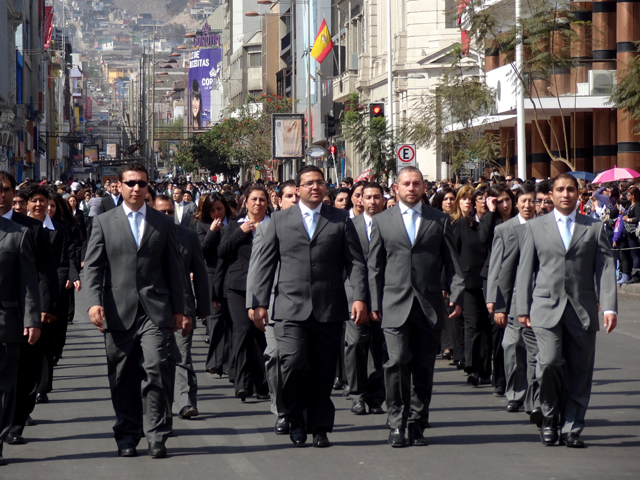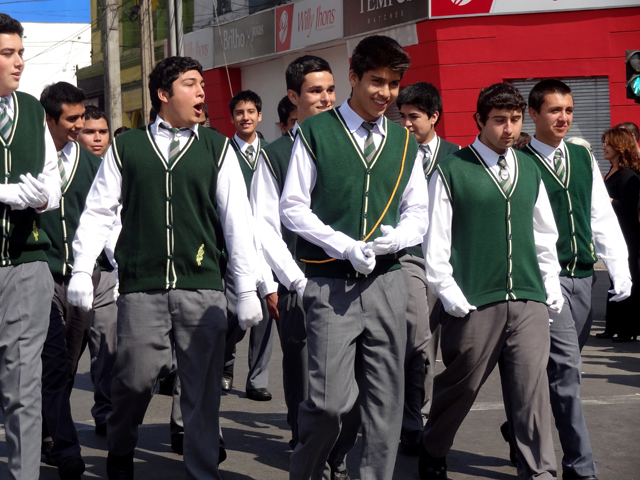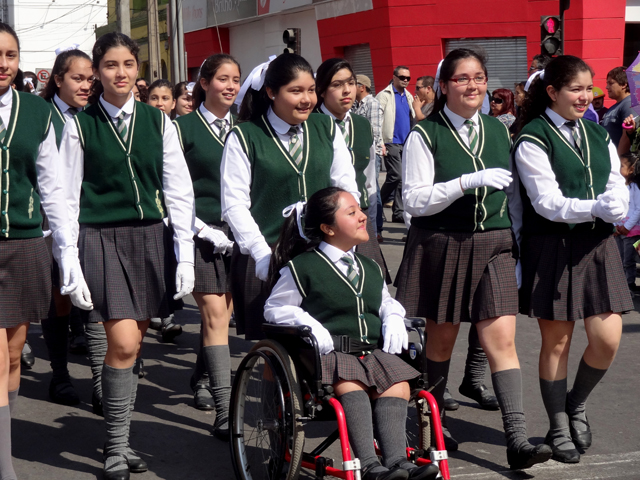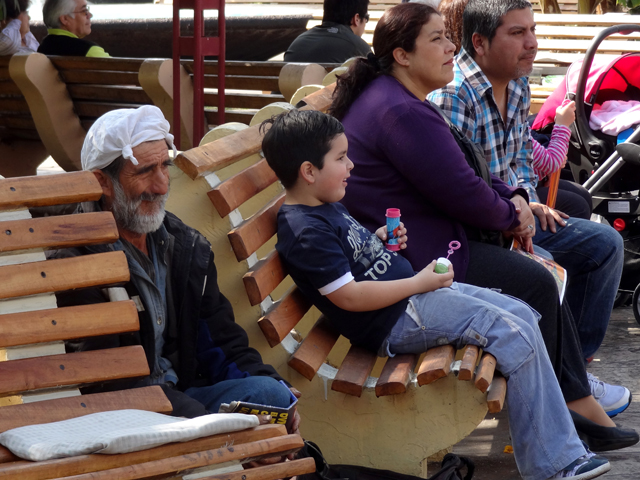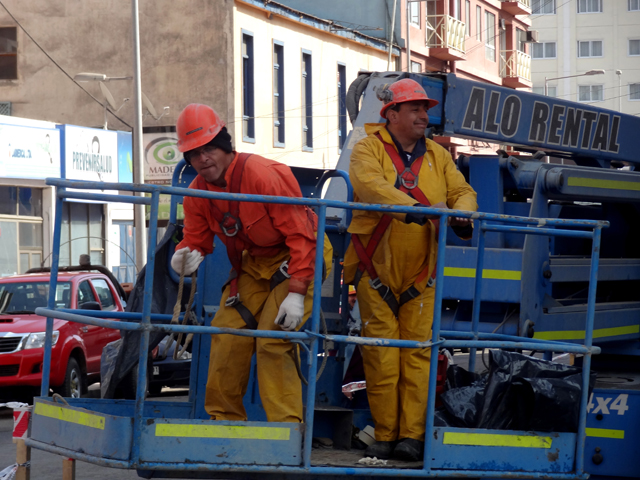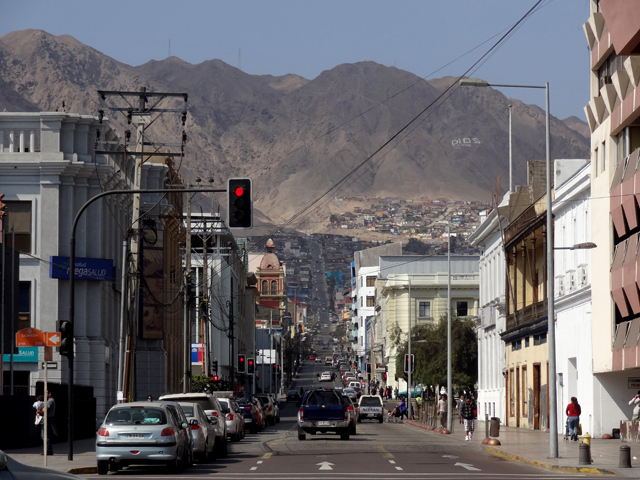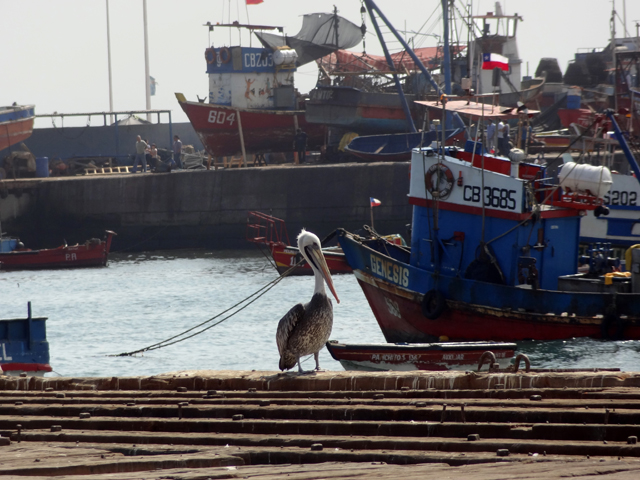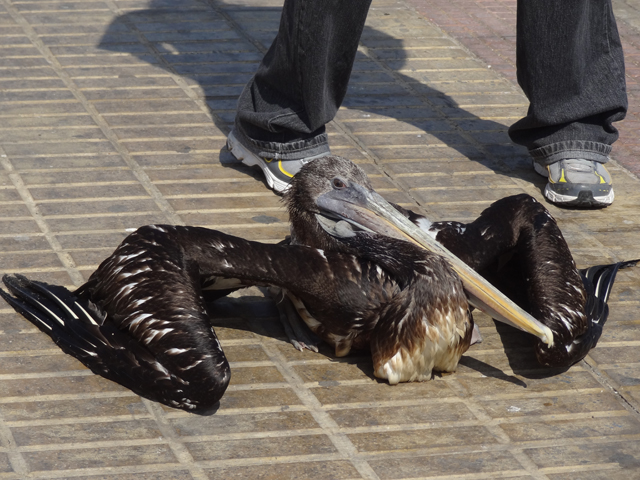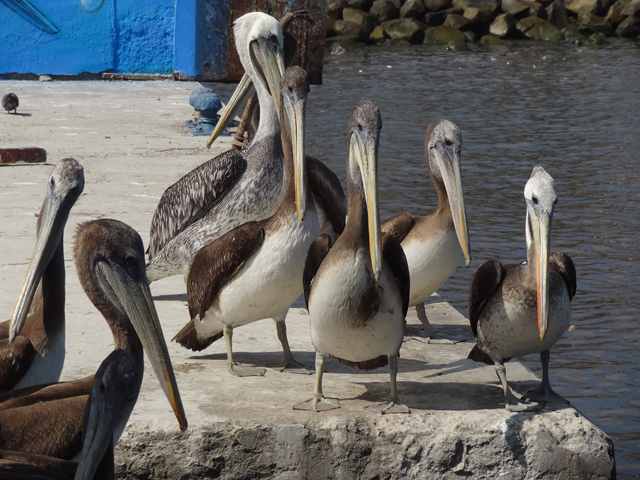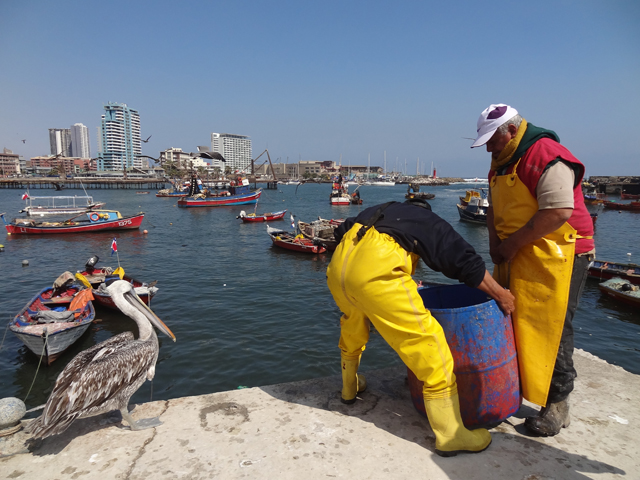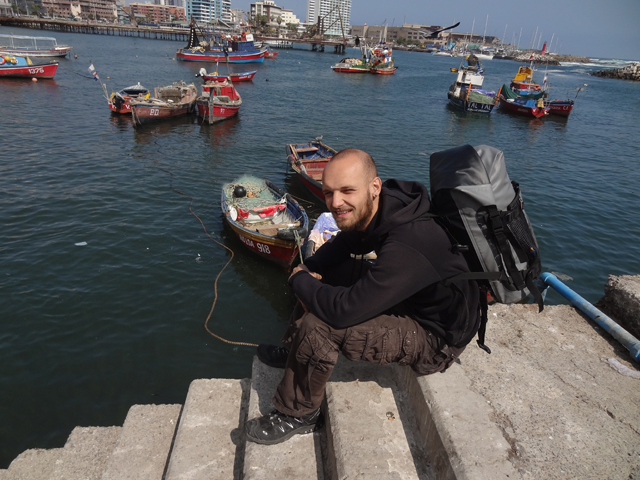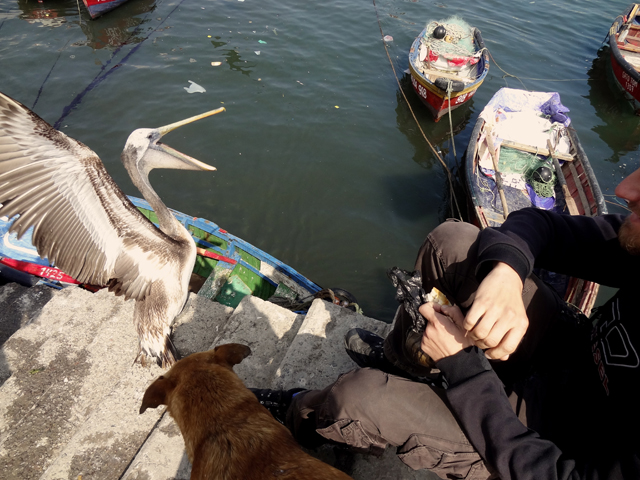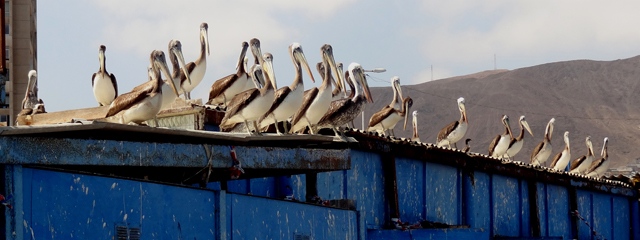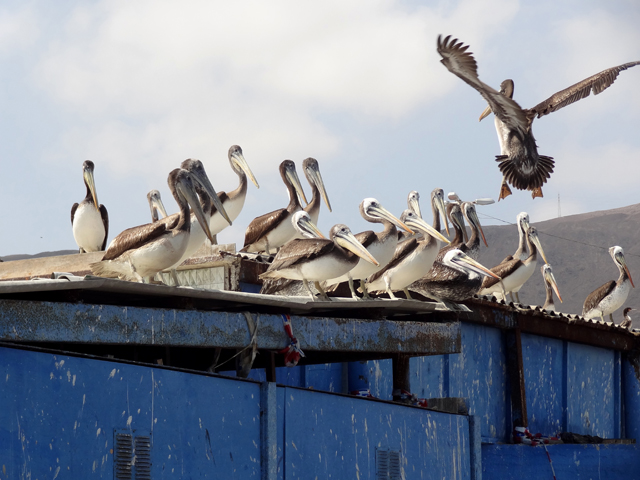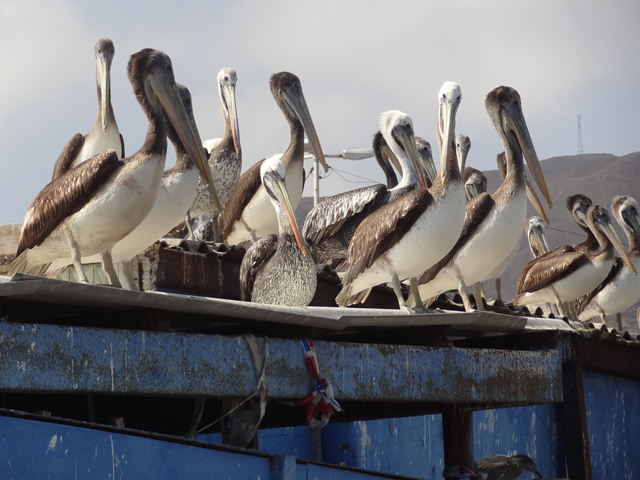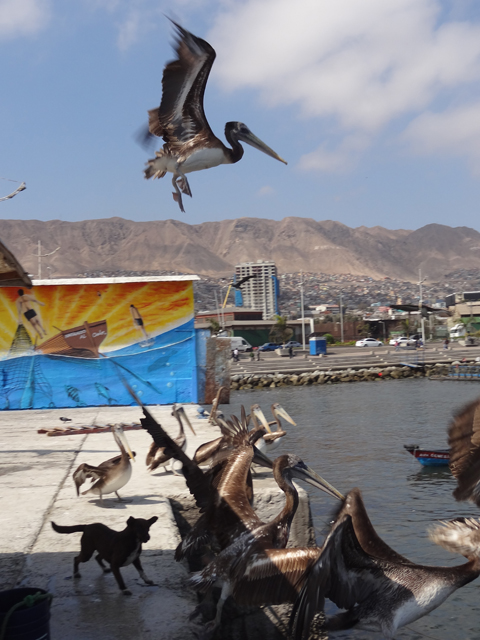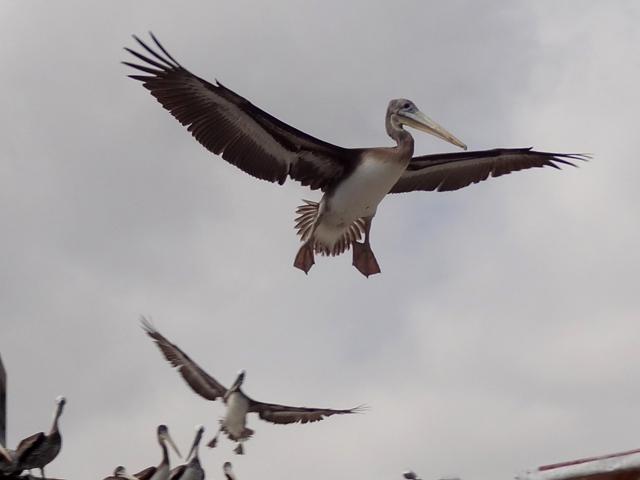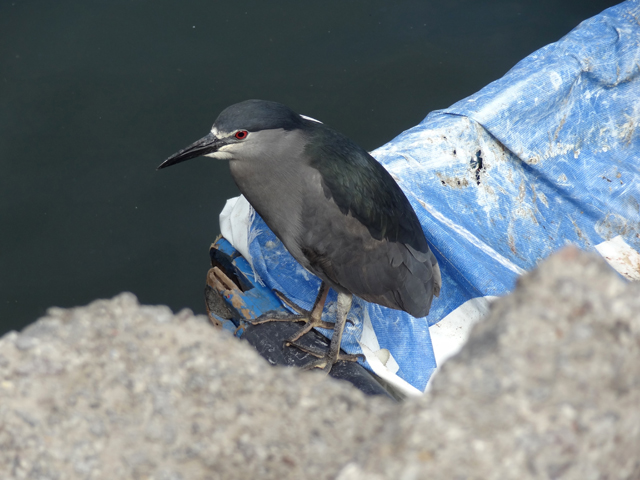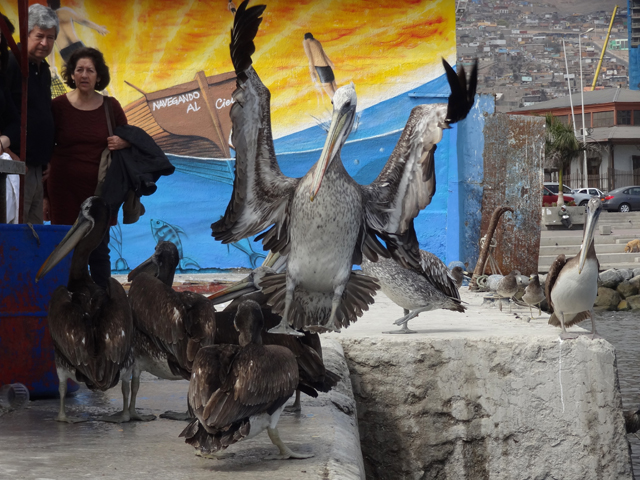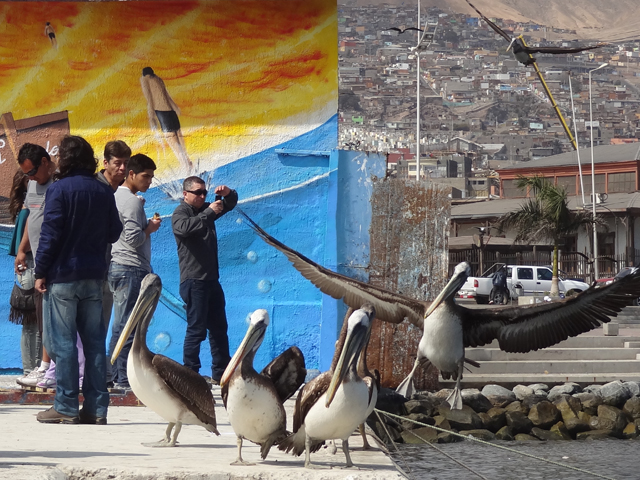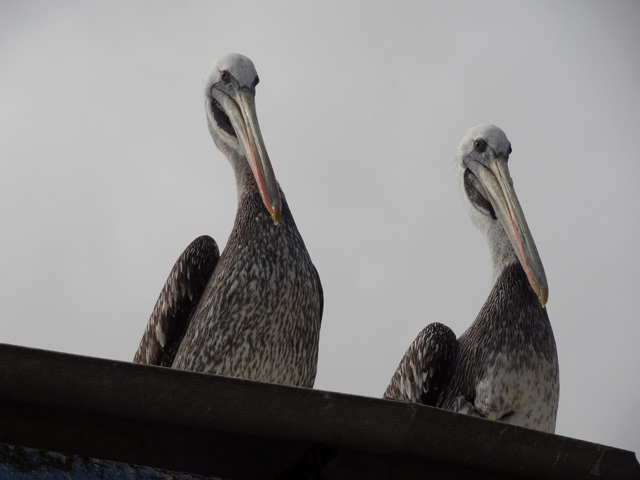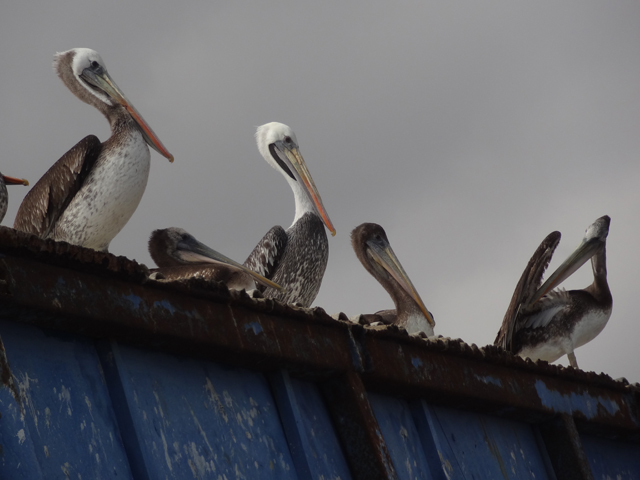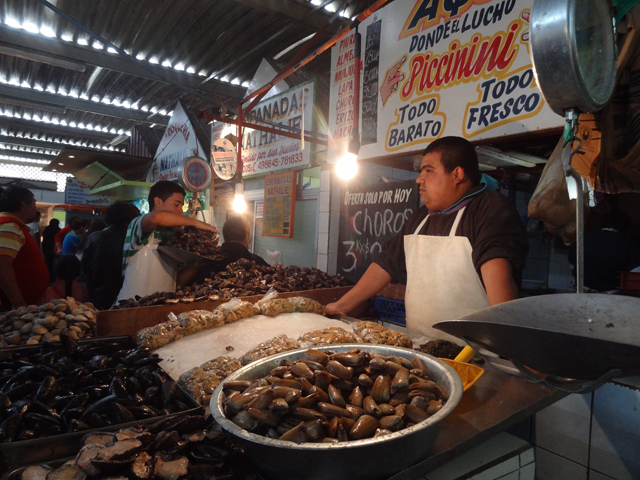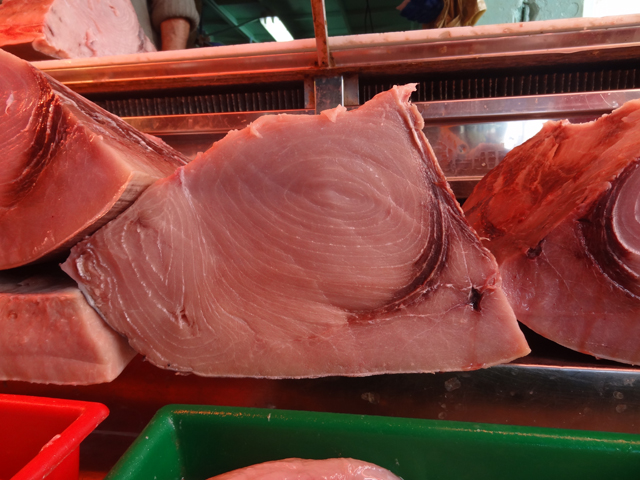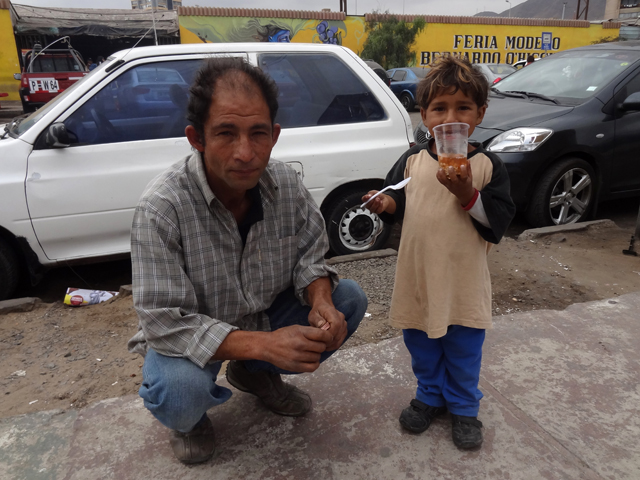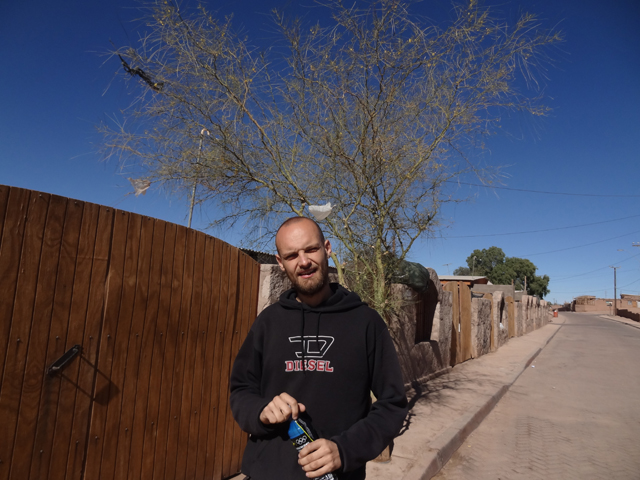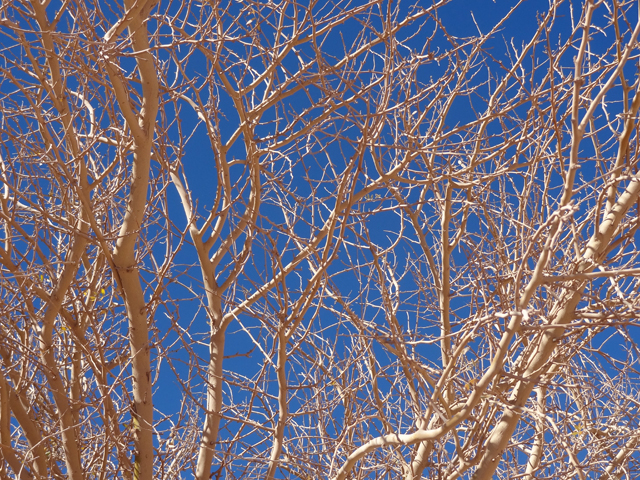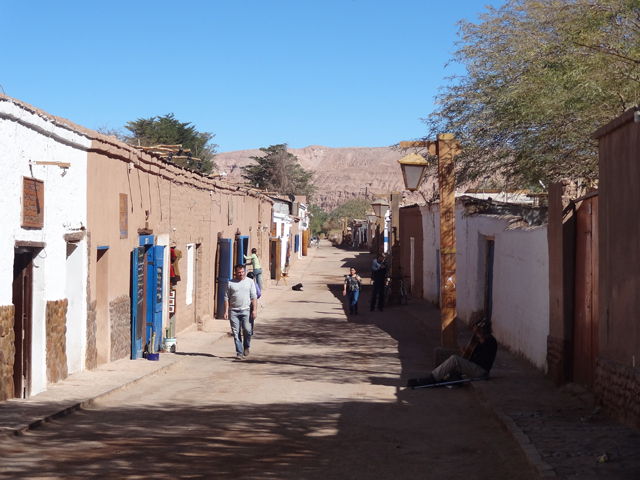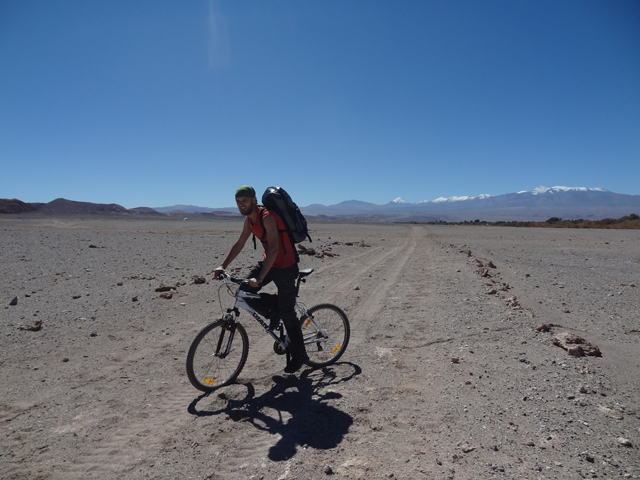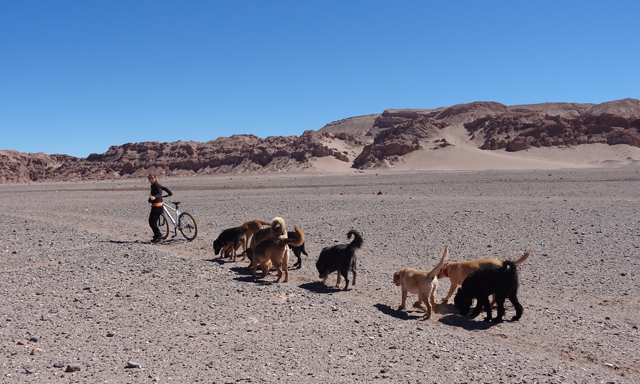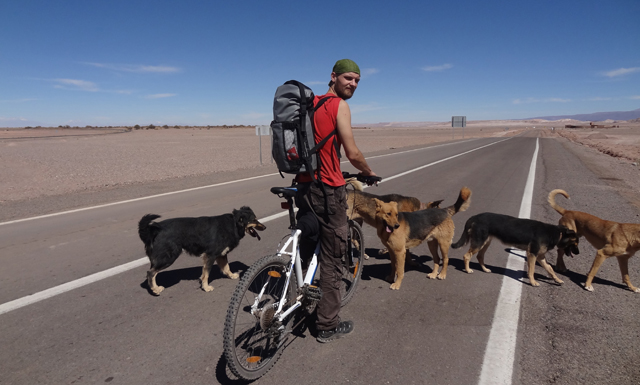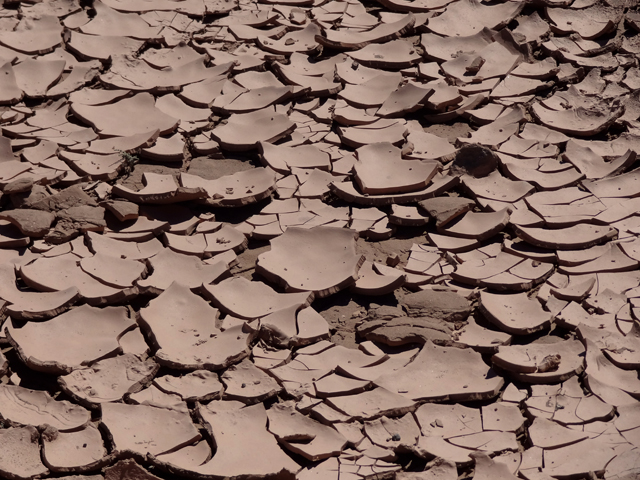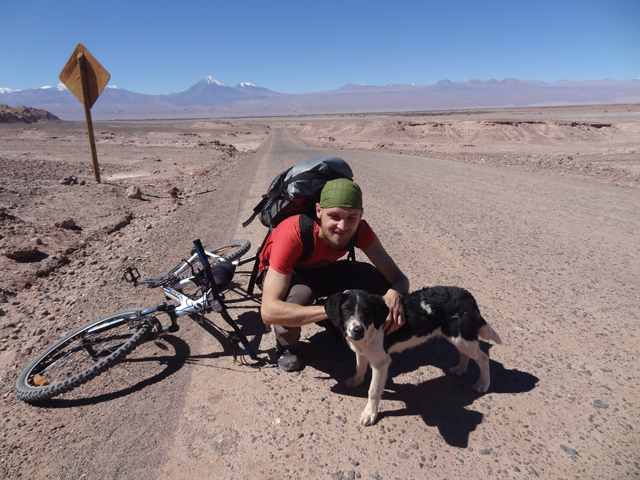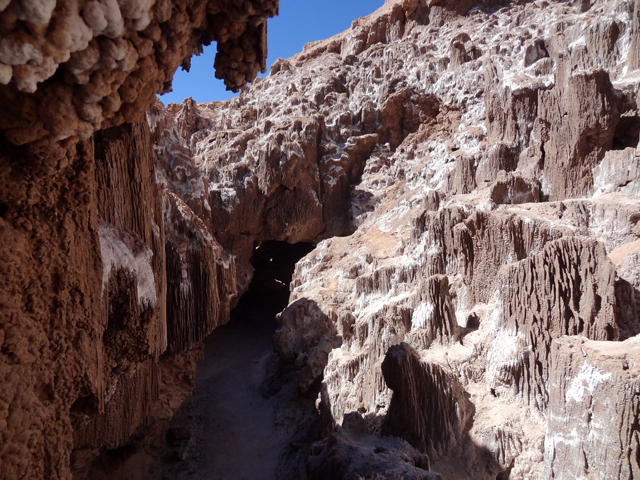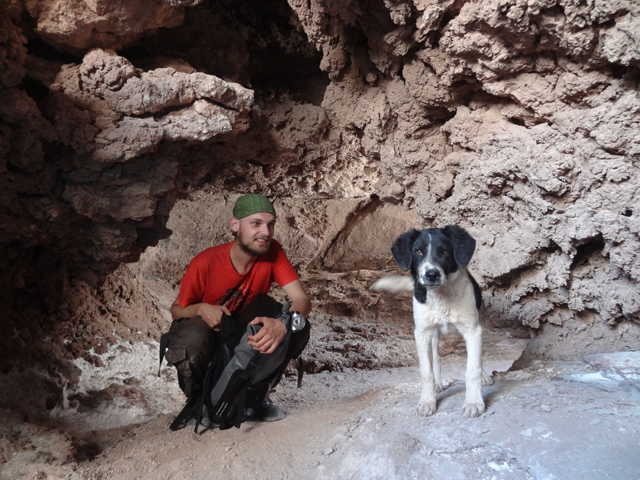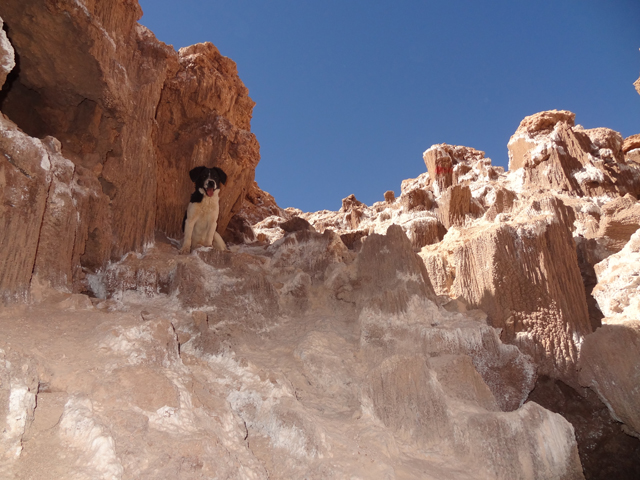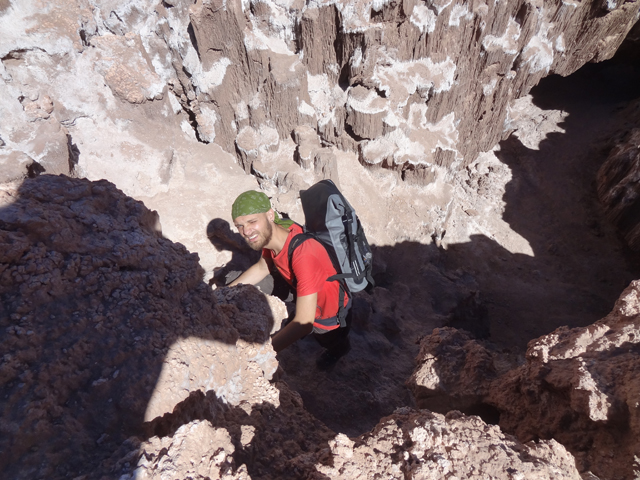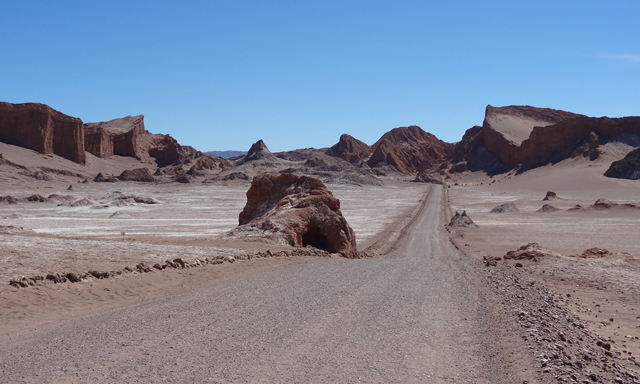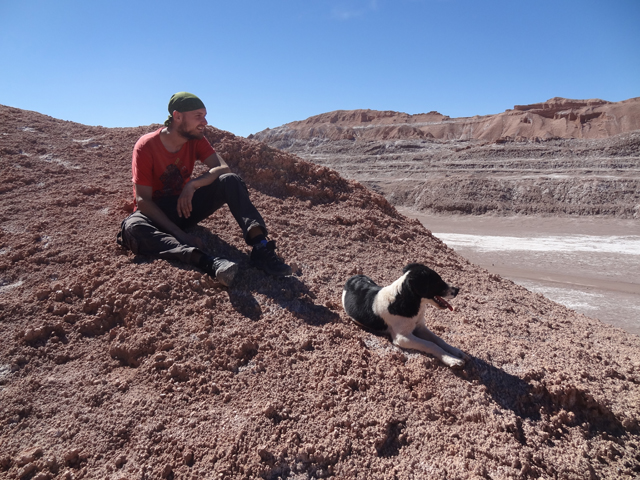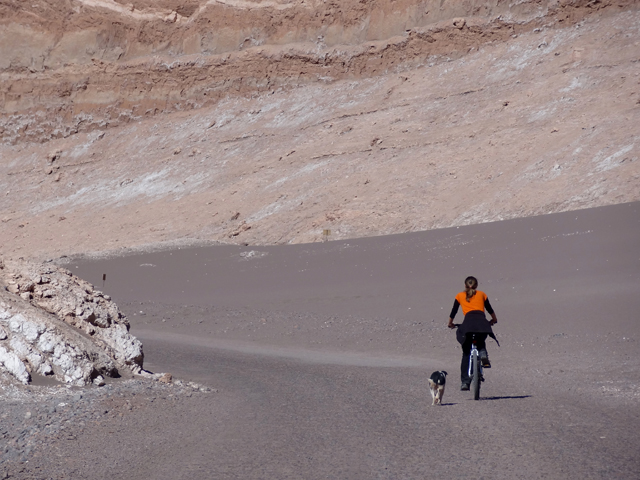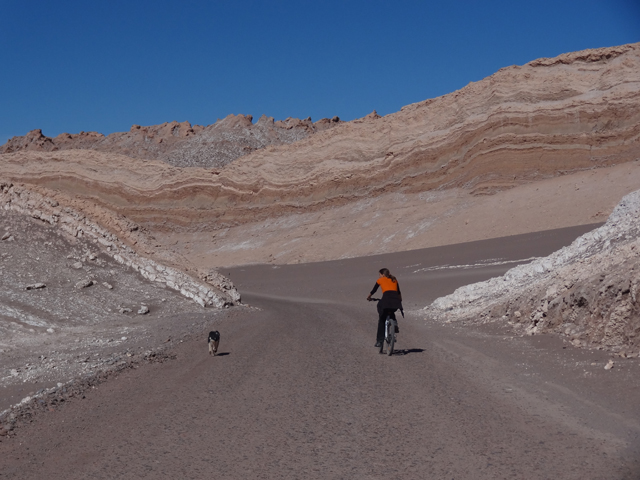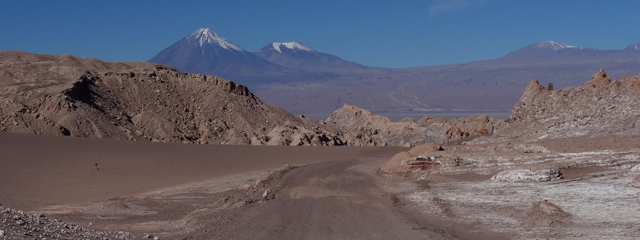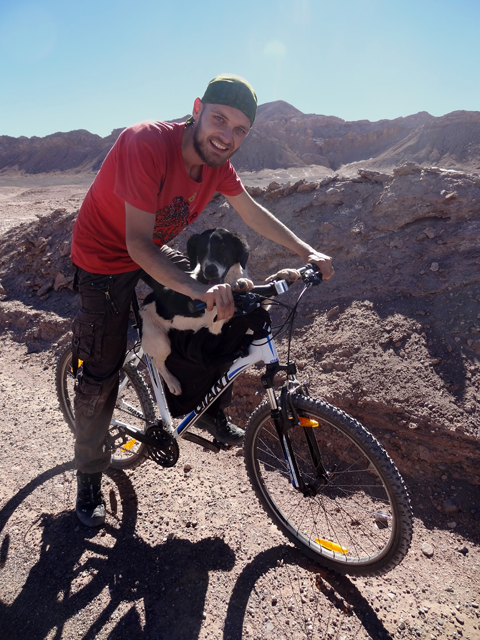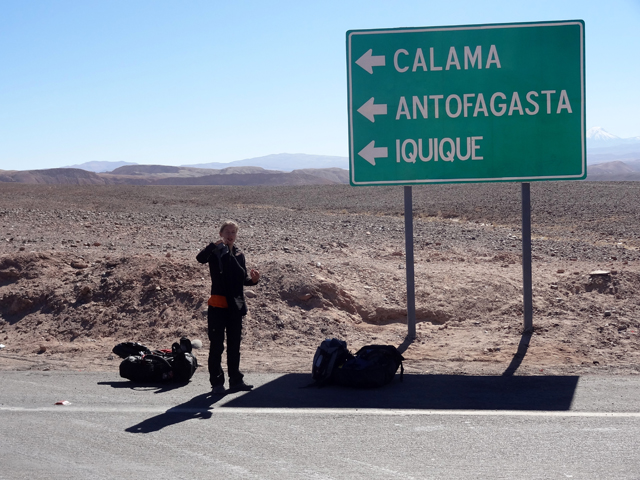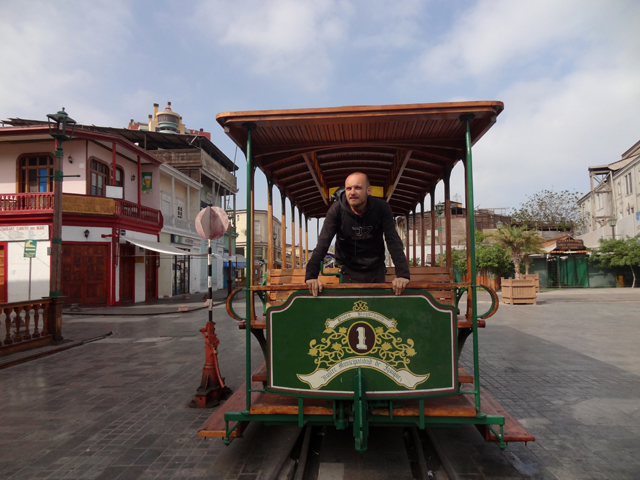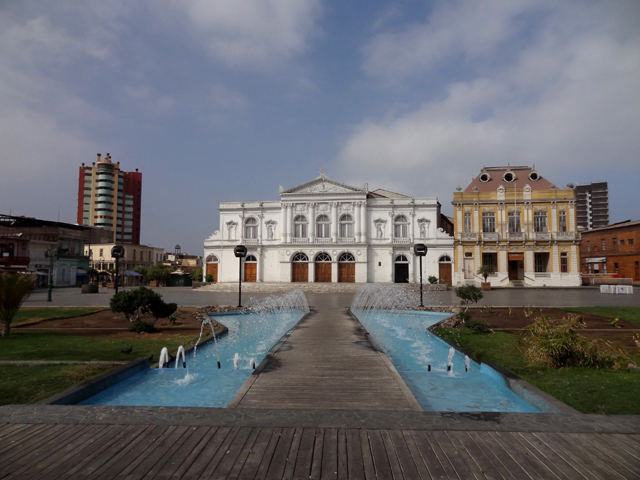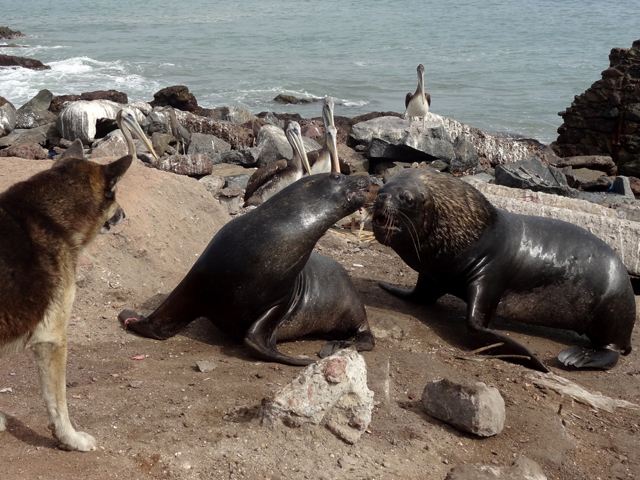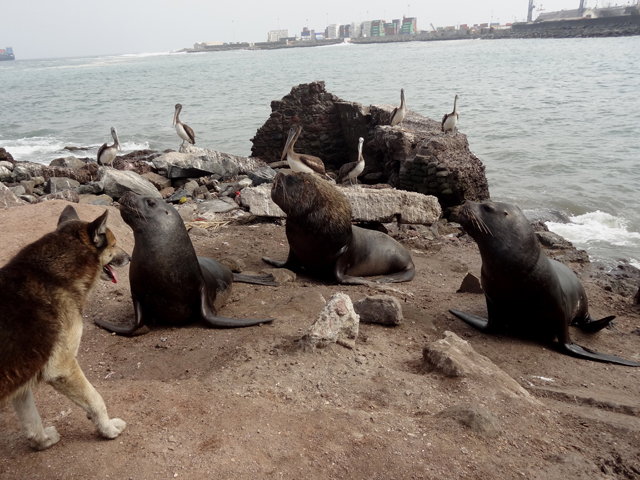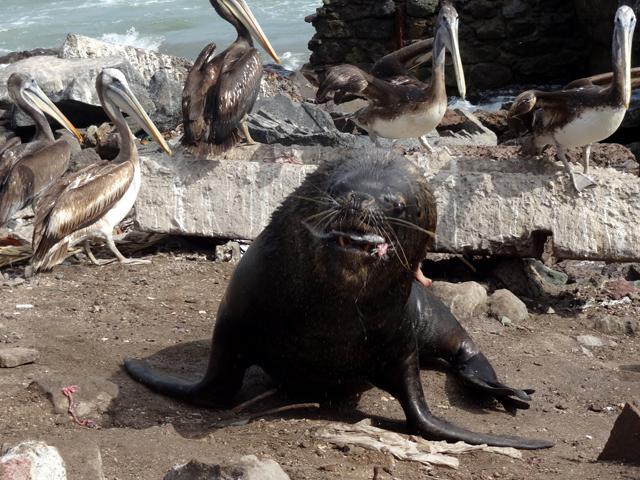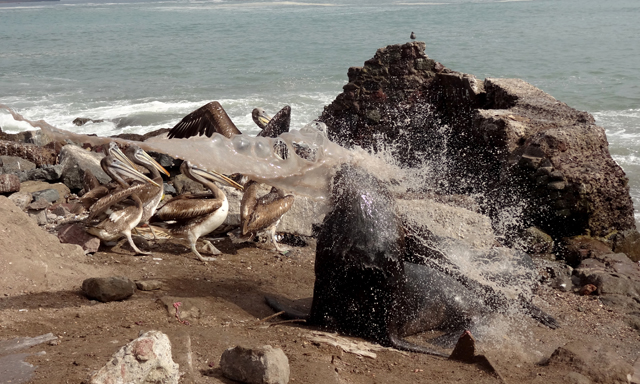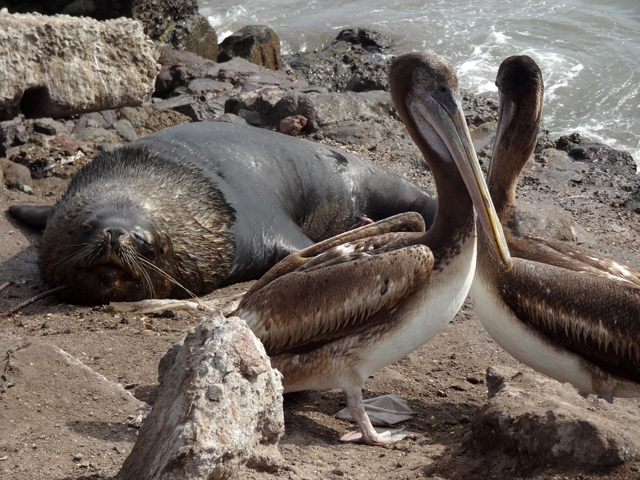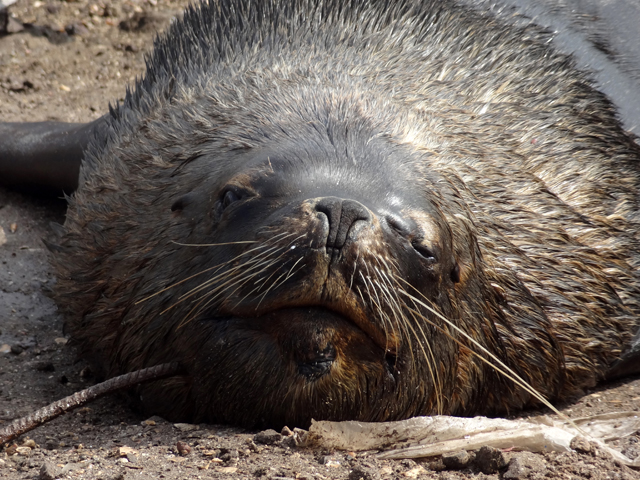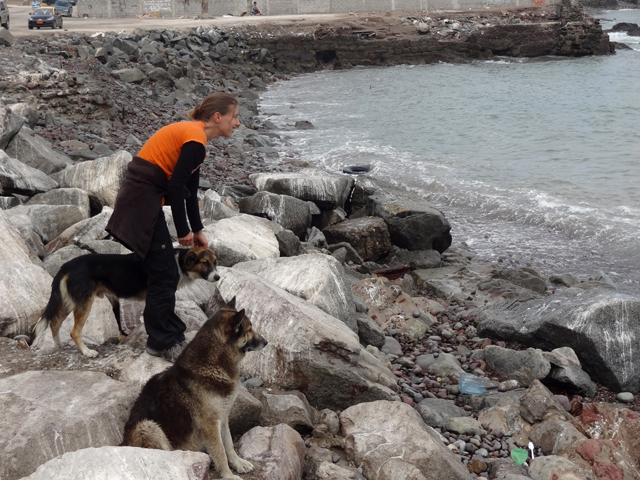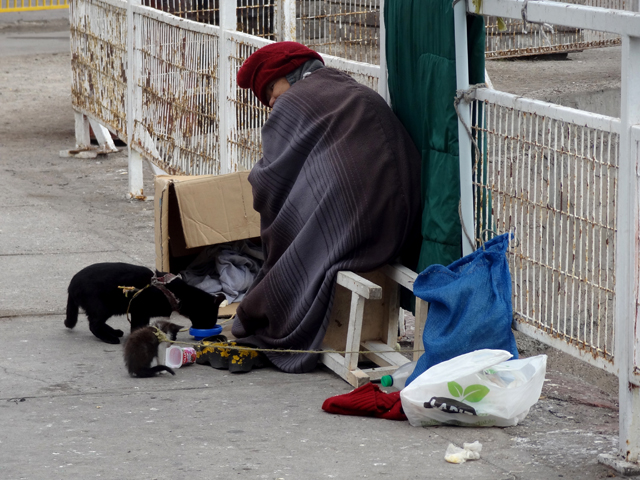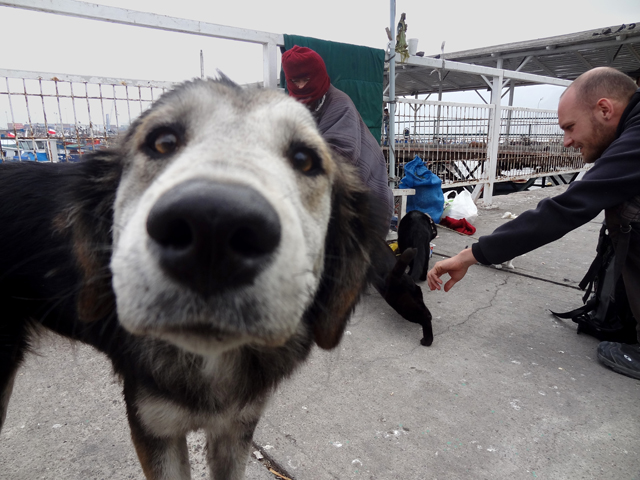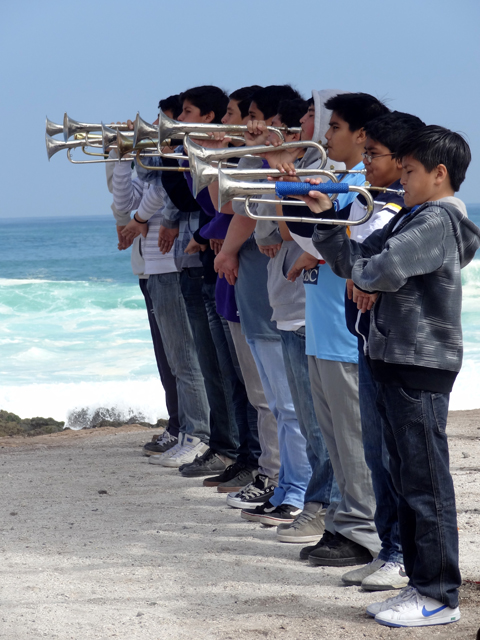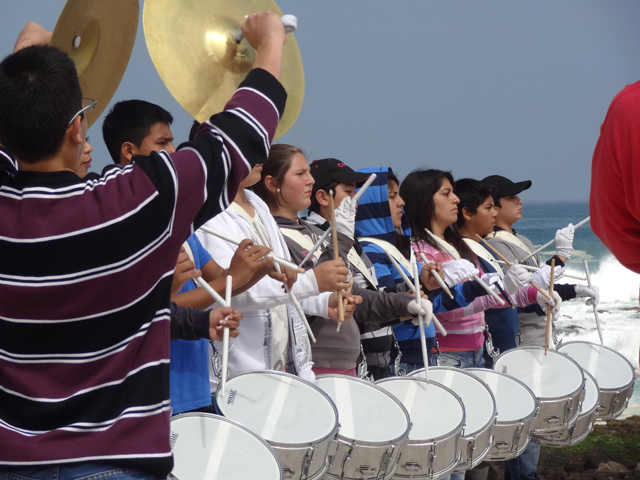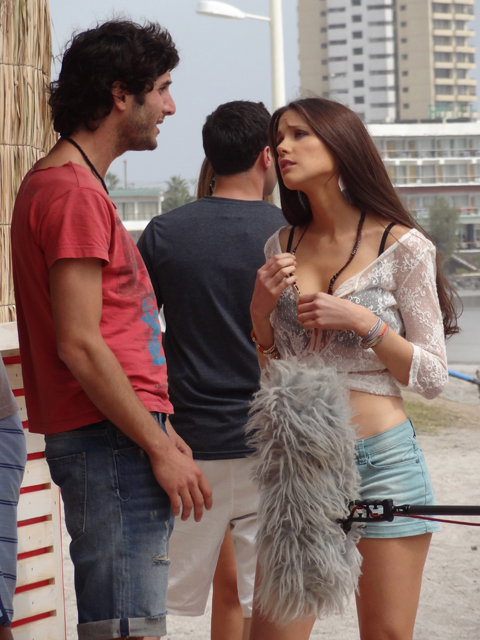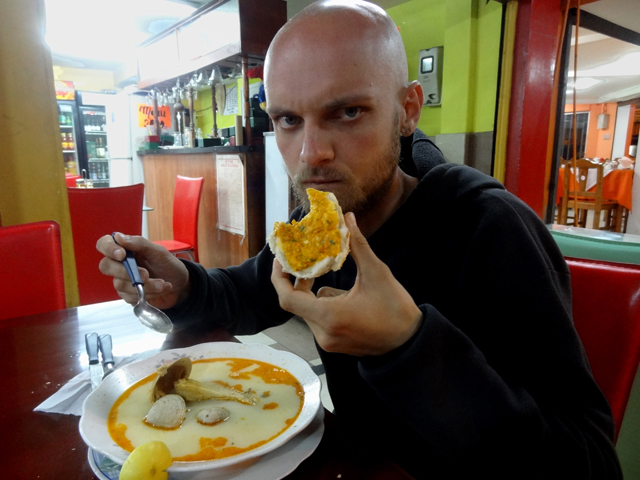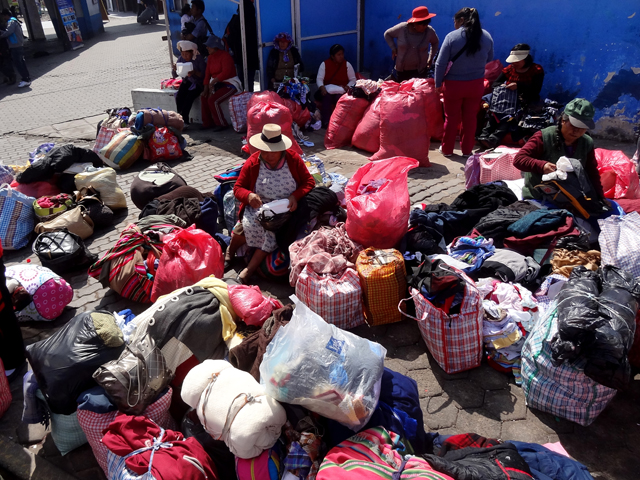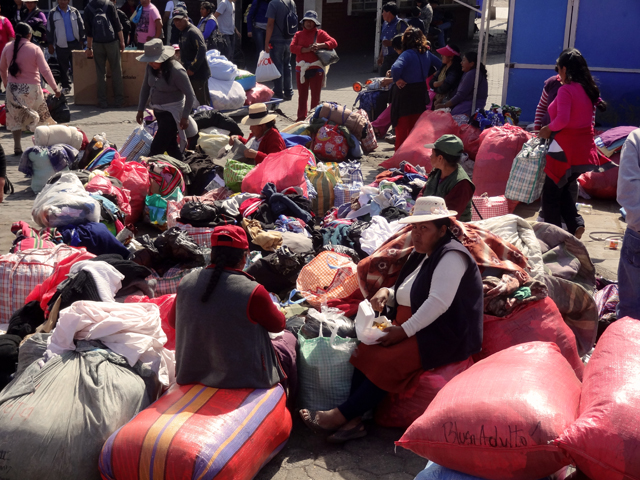Chile - mountains, hitchhiking, coastal desert cities and pelicans
Snowfall in Punta Arenas:
Chile greeted us by a spectacular snowfall with huge snowflakes swirling around the giant shrubs with fancy "haircuts" (a signature plant of Punta Arenas) and roads so icy we had to be careful with every step. Punta Arenas was a sweet little town and we saw almost the whole of it just looking for a hotel (for some reason all the ones around the terminal were full). Not far from the centre we managed to find a guesthouse with a charming lady owner and spent a nice evening in the welcoming warmth of her huge house (with some rooms refurbished for guests). The next day we left for our first real destination in Chile - Puerto Natales, the gateway to Chile's most popular national park - Torres del Paine.
This Andean fox at the Chilean border probably prefers feeding on the prohibited food items that people have to throw away (grains, animal products and fruit are not allowed into Chile) than to hunt:
Punta Arenas:
Torres del Paine National Park, Puerto Natales:
In Puerto Natales we found our hostel - the spotless and cosy Lili Patagonicos, with a really nice Spanish guy at the reception (whose real occupation and income source is playing online poker) - and on learning that the road to our next destination - El Calafate in Argentina - would be closed for the next three days and the weather would be bad for the next two, decided to postpone our tour to Torres del Paine till the last day in Puerto Natales.
The few quiet days we spent there were filled with leisurely activities like updating the website, feeding the street dogs and watching the Olympics on the big flat TV in the living room of the hostel. On the last day it was indeed sunny (although extremely windy as well), so we took a tour to the national park. And while the best way to explore the gorgeous mountains (or "towers") of this park is trekking through it, winter is not the hiking season, so we had to settle for simply seeing the mountains on a tour. The itinerary included the Milodon Cave (the one where they found remains of a human from around 6000BC and a giant ground sloth called Mylodon - a species that used to roam the Chilean Patagonia till about 5000 years ago when it became extinct); various viewpoints for the mountain ridge (Torres del Paine); Laguna Amarga; the Gran Salto waterfall with gorgeous turquoise water and a small rainbow at the base (a beautiful sight but the walk to this waterfall cost us tremendous effort due to the extremely strong wind common to the area because of the very specific air pressure conditions); Lago Pehoe - a peaceful lake with another very dreamy viewpoint of the towers; and a viewpoint for Glacier Grey with the main attraction there being the huge bright blue blocks of ice that floated from the glacier all the way to the shore of Lago Grey.
Torres del Paine tour:
Guanacos and Andean ostrich, through the window of the minivan:
Gran Salto waterfall with a rainbow at the base:
Lago Pehoe:
Blocks of ice from Glacier Grey at the shore of Lago Grey:
Going to the north via Argentina:
Since there are no roads in the south of Chile and for this same reason we'd postponed one destination in Argentina till our trip back to the north, before we could continue our route in Chile we needed to go back to Argentina (hence the multiple entry visa I'd applied for). El Calafate with its star attraction Glacier Perito Moreno was our only and last destination of this second entry in Argentina, and from there we took a really long (couple of days) bus trip up to Bariloche - the first city in the south which had the border crossing to Chile open. The problem with this crossing is that Andes being the natural border between Argentina and Chile, quite naturally the roads in winter often get closed due to heavy snowfall. Bariloche is one of the only cities in Argentina, together with Mendoza, that has a real highway to Chile and correspondingly proper road maintenance. Since according to our estimation we didn't have much time left till Joaquima's flight back to Barcelona, we skipped the off-the-beaten-track southern part of Chile and as our first destination for the second entry chose Pucon - a city on roughly the same latitude as Bariloche located right next to the perfectly conus-shaped Villarica volcano and close to the Huerquehue National Park.
Villarica volcano:
Huerquehue National Park, Pucon:
While we would've loved to climb to the crater of the volcano and see the lava inside it, the 70 USD price for the equipment rental and a guide is a real fortune, so we skipped it and instead directed our hiking efforts at the Huerquehue National Park. It was a beautiful one day walk, which took us through the forest with thin bamboo groves along the bank of the Tinquilco lake up to the viewpoints of the volcano, and then higher up through a snow-covered icy path to a magical place with half-frozen lagoons (Lago Chico and Laguna Verde), umbrella-shaped millennium Araucaria araucana (or monkey tail) trees and beautiful colour balance created by the combination of the warm green of the bamboo and the cool white of the snow. The climate in this national park is so special that all along the path we could feel gushes of warm air stroking our skin from time to time as we would cross thermoclines.
Our only other visit in Pucon apart from Huerquehue were the thermal waters Los Pozones - a small family-run mineral baths place located in a very picturesque spot an hour's drive from Pucon. Jordi and I spent the entire time in the steamy waters chatting to an ex-hippie expatriate from US who told us a lot of curious things about his life philosophy (which had some matching points with our own), love for bio-dancing and current lifestyle under the slogan of "dignified poverty" as a reiki professional working with celebrities.
Loz Pozones:
Santiago:
The capital Santiago was our next destination (and the last one for Joaquima). Since it was weekend and the buses from Pucon were booked out, we went via a nearby transport hub Temuco (an itinerary which we had to suggest ourselves to the bus operators since taking initiative doesn't seem to be part of the Chilean national psyche). It cost the same time and money and next morning we arrived at the big terminal of Santiago. We started the day pretty early (around 5am) but half of the morning was eaten up by an unfortunate hotel booking, as we had to wait for a couple of hours at a tiny cold reception of an office building for the travel agency/"hotel" management to come to their office at the usual office hours (it's a mystery how the few apartments in an office building without any reception could qualify as a guesthouse on hostelbookers). When the guy from the agency finally showed up, there were more surprises in stock for us - the room didn't match even our discounted expectations shaped according to online photos and the guy wanted separate payment for a heater in a room that didn't have any and therefore had the temperature of a morgue. Since neither the "office hours" reception, nor the absence of heating were mentioned in the hostelbookers profile, we didn't have much trouble getting the deposit money back, and at 10am were all set to look for our next hotel. We found it after a short while, in the same area of Baquedano metro station - aparthotel "Forever" with a spacious (although not so clean) room with an individual kitchen, heating - and for less money than the previous fake "hotel". We dedicated the remainder of the day to the customary city tour, but since Santiago is such an ordinary capital, there's nothing much to say about it, except that we ran into some kind of police meeting at the Plaza de Armas square at which many officers were present on horses and with dogs.
"Nos estan cagando la vida" literally reads as "They are shitting our lives":
Police meeting at Plaza de Armas:
Day trip to Valparaiso:
Our last day trip with Jordi's mum was to the nearby coastal town Valparaiso. Apart from the usual sightseeing (the centre, the market, the port), we went to see the house of Chilean most important poet - Pablo Neruda. La Sebastiana, called after the Spanish guy who designed it and died before moving in, is part of the cultural legacy Neruda left behind. Since the house is kept in its original look, its very special interior design reflects the hedonistic character of its owner, who due to abundant means earned over the years of diplomatic service as Chilean ambassador in France and some Asian countries, is not a typical example of a broke poet with nothing but inspiration (La Sebastiana is only one of his few houses). Personally, I am not a fan of Neruda's poetry, but I did find the interior design of the house very interesting, since it all breathed the personality of its owner and was full of curious elements which being items from other areas of life (like a steering wheel of a boat) when blended with the usual household articles create a truly nice interior design touch.
Market in Valparaiso:
An enormous "chorrillana" dish about to be shared by Jordi and his mum:
La Sebastiana and the view from it:
Funny cats:
Student demonstration:
Our last day in Santiago was a lucky gift from Air France which quite unexpectedly postponed Joaquima's flight by one day and gave us exactly enough time for all the last-minute souvenir shopping and packing (as always, some part of our stuff - including a musical instrument, a charango we bought together with the travel-sized guitar in Bolivia for my collection of ethnic musical instruments - could go back to Spain). Quite in line with all the demonstrations we'd been seeing all over South America, that extra day we gained in Santiago due to Air France coincided with a major student demonstration. That day we woke up to the sound of thumping feet and agitated talking in the street right next to our window. As we went to the street to see what was going on, we saw young people running in our direction escaping from the tear gas spread by the police in the big avenue. They had halves of oranges to breathe through and flags with crossed-out swastika signs. From the two college girls that stopped right next to our hotel we learnt that they were protesting against the lack of public universities. Switching on the TV we learnt about the full scale of that demonstration - three burnt buses at the city's main square, over four thousand participants and quite violent clashes between the students and the police with students throwing bottles of paint and molotov cocktails at the police cars and the police using water jets and tear gas. There was so much tear gas spread around the couple of big avenues where the demonstration took place that it hurt our eyes to walk them for the remainder of time we spent in Santiago (which was a couple more days). But the gas and water don't stop the Chilean students and highschool pupils, as demonstrations which started in April 2011 are still going on, with ensuing fatalities, arrests and attendance numbers occasionally reaching massive numbers (from hundred thousand to a million people). The students demand a thorough reform of the educational system which suffered from severe cuts during the regime of Pinochet and has shaped into one of the most expensive in the world, with no central government control over the public educational institutions, inability for people from poorer families to excess to prestigious private universities due to unsustainable educational loans and absence of laws against for-profit approach in higher education. And while the protesters' demands are very clear, the response of the government of Sebastian Piñera who in response to the protests in three successive responses proposed to set up a fund to provide annual support for public education, reduce the government-backed student loan rates to 2% APR, but at the same contrary to demands suggested legalizing the for-profit activity of educational institutions, so far has been labelled by the Chilean public as a patch and a step backward rather than a proper solution.
More sightseeing of Santiago:
The following day we saw Jordi's mum off at the airport and spent the afternoon visiting a few more places in Santiago: the Santa Lucia viewpoint with a foggy/smoggy view over the city and the Museo de Bellas Artes. Here we were almost the only visitors apart from a group of school children taking careful but seemingly indifferent notes for the future school report (I've never seen a kid genuinely interested in Roman sculptures). It was a really small gallery (on the Louvre or Hermitage scale), but had a really interesting exhibition hall of the Chilean painter Andrés Gana. The best way to describe his paintings would be as "an explosion of sensuality", or if Milan Kundera would paint on top of writing he'd probably produce something in this style.
Santa Lucia:
At the Bellas Artes gallery:
A painting by Andrés Gana:
Hitchhiking from Santiago to Antofagasta (1200+ km):
The next day - August 10th, 2012 - will go down in our personal history as the day we started hitchhiking (I'd done it with a friend in my student years in the Crimean peninsula in Russia but together with Jordi it was the first time). And while we believe that people's hitchhiking experiences vary over a whole horrible-to-awesome range, ours so far has been absolutely great. The seed about hitchhiking was planted in our minds by a Belgian couple we'd met in El Choro trek back in Bolivia, and an extra incentive to do it was the fact that with the departure of Jordi's mum the sponsored part of our stay in Chile had come to an end. With the transport in Chile being pretty expensive (it would've cost us a couple hundred dollar to cross the country all the way to Peru), we decided that seeing the desert landscapes of this country through a windshield of a truck would not be a bad alternative to pricy buses.
Having done our homework by reading about hitchhiking itineraries in Chile, to get out of Santiago we first took a metro to Puente Cal y Canto station. Over there we found a small bus terminal where we could take a public bus to the Panamericana highway. Something went a little bit wrong with the enquiry part for this bus, as after a while the driver dropped us at a highway where almost everybody was signing to us that they were about to exit. Sensing some problem, we walked a few metres back to the toll booths and asked the girls if it was the right highway. Well, of course it wasn't, but luckily we were within walking distance from the right one. Following the directions, we'd been walking through desolated industrial area with nothing but huge warehouses for about one hour when we finally found the Panamericana highway. Our first truck stopped after about 10 minutes. Its elderly driver Juan makes two daily trips on the same route each day of his life transporting cement, loves his job, has about a thousand friends on facebook and jokes all the time (although has a very peculiar sense of humour). Having resolved our biggest challenge for that day - get out of Santiago - he dropped us a couple of hours later at a gas station close to the city of Calera. Our second truck also picked us up pretty fast - the two brothers Jairo and Gustavo were transporting a container-load of Cristal beer all the way up to Coquimbo (somewhere 1/3 of our way to Antofagasta). Both ex-carpenters they liked the change to trucking, loved their job and liked a good joint of natural marihuana (which they smoked most of the way). Together we made it all the way to Coquimbo - a coastal resort town - by about 10pm. By then we were already quite settled on the idea of spending the night in that city and started to research the options by checking the beach area where the marihuana brothers dropped us. The beachfront bungalow resorts were full of barbequing locals and turned out to be pretty expensive (with none of them offering camping lawns). The beach didn't look like a safe place to camp (and all the locals confirmed it), so our next move was to go the city centre and look for cheaper accommodation. But I guess our hitchhiking guardian angel had a different plan, as a while later after we started waiting for a public bus to the centre and put out the thumb to a passing truck just for fun (with no hope to be picked up since it was so late), a truck - the third one for that day - did stop. This one became a really amazing experience, as our driver Patricio turned out to be an absolutely great guy.
Here's why we think that if there were "hitchhiking host" awards, he'd definitely deserve the top prize:
- He picked us up at about 11pm!
- After a while it was time to sleep, and since the guard at the truck parking didn't like the idea of us putting up the tent on his lush grass lawn, Patricio suggested we use the second bed in his truck to sleep. It was very comfortable and we skipped the hassle of putting up/disassembling the tent.
- He gave us a welcome treat of a couple of bottles of sports drink, and kept treating us to bottled juices the whole next way.
- He had a DVD player and let us choose the movies from his collection. According to Jordi, with all the movie-watching the trip was not long enough :-)!
- He kept checking with us whether we were comfortable, hungry, bored etc. with the idea to fix any possible discomforts so that we could enjoy the trip.
- When we arrived in Antofagasta at about 9pm the next day, he dropped us a couple of blocks from the centre - it was impossible to deliver us closer to our destination.
As I was taking the photo of this oranges, the two guys who were unloading them offered us to take some. Since our hitchhiking day went really smoothly after this first gesture of kindness from strangers, we called them "lucky oranges":
Hitchhiking from Santiago to Antofagasta:
Antofagasta - school parade and pelicans/sealions feeding show:
Now, while Antofagasta is not a major highlight according to the travel guides, we ended up having the time of our lives in this city (along with one more coastal desert city - Iquique - higher up the coast). We spent the night at a hotel whose owner had a huge collection of perfumes (unfortunately, we couldn't contribute any since perfume qualifies as excess weight for a rtw traveller) and started the next day by walking the centre and taking some photos at the local weekly school parade where the kids marched through the main square at the accompaniment of their band. After the parade it was time for kids to have the usual merriment of eating candies, ice-creams, buying toys and chatting with parents and friends. We left the merriment to take a walk to the port and discovered that we arrived right on time for the absolute highlight of our stay in Chile - the pelicans/sealions feeding show. While it wasn't mentioned in the guide, we discovered that during the weekend the local fishermen come to the port to sell the fish and use pelicans and sealions as waste recyclers. While they are cutting and cleaning the fish they throw every single piece of waste to these animals which are queueing neatly according to their superiority hierarchy (sealions before the pelicans) and catch the pieces on the fly once it's their turn. The street dogs are supervising the feeding process by barking at and even attacking both the pelicans and sealions from time to time and although largely ignored they probably think themselves to be of indispensable service to the fishermen. Once fed, the pelicans line up along the edge of the picturesque roof of some nearby building, making it a shot to die for... Since by the end of the show the pelicans and sealions were fed but we were hungry, we went to the seafood market right in the port and treated ourselves to the delicious seafood empanadas.
Weekly school parade, Antofagasta:
Pelicans and sealions at the harbour:
Seafood market:
Bike trip through Valle de La Luna, San Pedro de Atacama:
The same day we took a bus to San Pedro de Atacama (no hitchhiking since this was a relatively short trip that would have cost too much effort to get to the right point of the highway compared to the money we'd save). Exploring the Atacama desert was of course our sole objective in San Pedro, so we spent the whole next day cycling through Valle de la Luna and along the nearby salar. And while the landscapes of this driest desert in the world are really beautiful, we think that it's nowhere close to the breathtaking scenery on the Bolivian side of the area which we saw during our Uyuni tour.
San Pedro village:
Bike trip to Valle de La Luna, Atacama desert:
We found this dog biking through Valle de La Luna. After we gave it water, it kept following us during the whole trip till we were back at the first point of civilization - the ticket office:
All-about-mining hitchhiking trip from San Pedro to Iquique:
With one day being more than enough in this extremely touristy village with overpriced accommodation and no supermarkets, the next day we left for our last destination in Chile - the coastal city of Iquique. Our hitch-hiking guardian angel once again was working very hard, as we managed to make the whole route pretty smoothly in about the same time it would've cost us by bus. The driver of the first car that picked us up at San Pedro makes weekly trips to the village to sell a couple of barrels of petrol (one of them - luckily empty - flew out of the trunk of his 4WD so we had to back off and pick it up in the middle of the highway :-). He dropped us off at Calama, a couple of hours away from San Pedro, at the crossing to Chuquicamata mine. And while the miners are not really allowed to pick up hitch-hikers, with our guardian angel still busy, the driver of our second car turned out to be a miner and gave us a 17-km lift to Chuquicamata to the main crossing on the way to Iquique. Here I should mention that Chuquicamata is the biggest copper mine in the world and is the one where Che Guevara met the young couple and learnt all about exploitation of miners during his trip through South America ("Motorcycle Diaries" is one of our favourite movies). Our last driver was also a miner and confessed that he was a bit sceptical about stopping (since hitchhiking robberies seem to be quite common in Chile) but something made him change his mind (our guardian angel maybe). The journey in his spacious jeep was super comfortable with mining being the main theme of this 5-hour trip: we passed kilometres and kilometres of desert with nothing but salt and copper mines and a few oasis towns. Everything we saw was about mining: the neat mine "terraces", huge mining machines (sometimes as big as both lanes of the road with a police convoy making way for them till their destination), cranes, trucks with the poisonous sulphur acid heading for the refinery plants, mountains of lemon-coloured sulphur powder at warehouses along the road etc. etc. Everything we heard from our driver was also about the mining: he works at the Chuquicamata mine and makes a pretty good salary (about 1600 USD); like most miners he works long 14-hour shifts and after four days of work has four days off (4x4); unlike Bolivian miners who can't work without coca, in Chile the miners pass a daily drug control with coca and even coca infusion (along with any other herb or drug) being prohibited. And finally, as part of his introduction to mining, he showed us a video of the whole production process at their refinery plant where they produce thin planks of copper from the extracted mineral and which (unlike the stone-age refineries in Bolivia) looked state-of-the-art. No wonder that being a miner, with his neat white hands and smart clothes he looked like he'd just stepped out of an office.
By late afternoon after a quick stop at the ghost miners town of Humberstone (a UNESCO heritage site located right next to the road not far from Iquique) we made it all the way to Ospicio - a town in the outskirts of Iquique where many locals move these days to be safer from tsunami's and earthquakes. We said bye and thanks to our driver who was in a hurry to see his girlfriend after 4 days of work and immediately on stepping out from his car caught a city bus to Iquique (just a short ride away).
Iquique - another pelicans/sealions feeding show and awesome surfing break:
The first sight of this city was a view we'd never forget: a giant sand dune hanging like a falling chunk of desert over a colourful stripe of typical desert city houses, followed by a grey stripe of the rugged long coast, followed by a white stripe of a ripping break, and finally followed by the aquamarine stripe of the Pacific ocean melting with the whitish sky at the horizon. Another shot to die for, but unfortunately the viewpoint is at the highway, with no bus stops possible...
Iqueque turned out to be another unexpected blast, as just like back in Antofagasta we found another weekend seafood market at the port, with the second series of the same animal feeding show and all the same participants (fishermen, sealions, pelicans and dogs). On top of that it was a really cosy colonial city which due to its desert location had a "wild west" look and feel about it and in some parts almost succeeded to look like a theme park. After a walk through the centre and the show at the port, we spent the rest of the day at the beach, watching the perfect break and all the surfers and bodyboarders, over all the jealousy swearing to ourselves to find a surfing spot in a cheaper country as soon as possible.
The centre of Iquique:
Pelicans, sealions and dogs at the harbour:
It was the first time we saw a homeless person with cats - just like we thought, it turned out to be a woman:
Iqueque beach:
A school band rehearsal:
Shooting of beer commercial:
The market:
Smuggling two pairs of jeans from Chile into Peru as part of otherwise normal immigration:
The very next day we finally headed for a cheaper country - Peru, by taking a 3-hour bus to Arica and changing to another bus to the first Peruvian city after the border - Tacna. This border crossing located in a Chilean offshore zone (no taxes!) was a very special experience, as we witnessed how lack of humane procedures can drive people to the edge of dignity. This is what happened: in Arica the international bus terminal for Peru was packed with Peruvian women surrounded by piles and piles of bags of second-hand clothes. Our bus was like a mini-version of the same scene, with most of the passengers being Peruvian women with bags of clothes. One of them approached us immediately on boarding the bus asking if we'd take a couple of pairs of jeans for her: it turned out that due to the low price of second-hand clothes (10000 pesos for a whole huge bag) in the offshore Arica, secondhand clothes became an item subject to customs duty. This, in turn, makes the few entrepreneurial Peruvian women assume the risks of losing the whole load of clothes on the border during the customs check, which they try to avoid through various tricks, like giving it to the few foreigners, wrapping piles of clothes around their bodies, hiding it beneath the seat covers and wrapping it along the curtain wire of the bus etc. The customs officers naturally seem to be acquainted with the majority of the tricks, so most of the clothes never makes it past the border and gets burnt at the customs (we could see piles of it right next to the immigration office), but the few items that pass are probably sufficient compensation of the trip expenses for these brave women... Talking to the Peruvian people on the bus that are not involved in this clothes smuggling, we saw that their opinion of the problem matched entirely our own: with all the poverty across the border, why not just give out all the confiscated clothes to the Peruvian people or let the women pass and sell it (probably at a price that locals can afford), or simply change the law and charge some small customs tax amount that will make smuggling redundant in a natural way? The world without nuisance regulations that waste human energy would be such a better place...
This secondhand clothes is about to be smuggled from Chile to Peru:
